#A Guide To RPG Map Making
Explore tagged Tumblr posts
Text
Pillars of Eternity to Avowed Pax West Panel
youtube
this hasn't popped up on my feed yet, so here y'all go. i'll see if i can summarize it a bit below (apologies for absurd length lol).
Josh Sawyer Pre-Recorded Interview
pillars ended up feeling a lot more traditional crpg than he expected
wanted to make the setting have a blend of the exploration of baldur's gate, dungeon crawling of icewind dale, & philosophical themes like planescape: torment.
while eora contains many things he is interested in, he doesn't feel much ownership over it. made the setting specifically for obsidian to use.
creating maps for pillars a lot more technically complex than for the infinity engine games.
maintaining continuity of feel more important than recreating everything one to one when talking about adapting the setting to 1st person action rpg.
Carrie Patel & John Cotto Live Panel
Carrie (game director) - first game at obsidian was as narrative designer on pillars 1. John (area designer) - first game was deadfire, fell in love with eora after playing pillars 1 in college.
setting the game in the living lands allowed the team to make a colorful & fantastical game - famous in lore for being legendarily dangerous & fantastical & unknown.far enough away from eastern reach & deadfire for a clean slate.
clean slate but there will be call backs and returning characters from previous games.
morrowind was a formative game for john. excited to get to create a game in that same vein.
carrie reiterates how she loves the mix of grounded physical layer & metaphysical layer & the player character's ability to move between the political & mystical. john also loves the metaphysics
john - area designer is akin to being a dungeon master. he is the official unofficial eora lorekeeper on the project.
carrie - classless system decided early on to encourage players to experiment w/ builds as they discover the game. talks about how most of the class abilities in pillars were learned vs innate.
john made sure to include "at least one" book of smut to be found in the world.
carrie - excited to explore animancy even deeper in avowed, i.e. a community of animancers who enhance their crop using essence to become living lands' breadbasket.
john - excited to explore a pargrunen dwarf community.
the team reworked the prologue to be more guided & endgame to let players actually use endgame abilities.
Fun Bugs!
rats that open doors
farmer mosh pit
Sporeling Space Program™
#avowed#pillars of eternity#eora#the living lands#pax west#pax west panel#obsidian entertainment#Youtube
58 notes
·
View notes
Note
would you happen to know about any ttrpg that could run/emulate the tone of STALKER/Annihilation?
Frail humain beings entering a Fucked Up Zone with the intent if reaching the center and things getting weirder and more dangerous the farther they go in?
THEME: Eerie Fucked Up Settings
Friend I have some truly excellent games for you this week.





TRESPASSER, by Binary Star Games.
The Zone is an area that's been sealed off by a nation or group of nations due to its danger. It's filled with Anomalies, extremely dangerous areas where physical laws like gravity, magnetism, electricity, or chemistry can break down to lethal effect, as well as mutants and things considered impossible.
Like many, you have entered the Zone, but not legally. You are collectively known as Trespassers. Some inside are on their own, some in groups, some part of larger factions. But most want one thing: to reach the centre and claim what it conceals.
This game can accommodate a GM but it isn’t necessary - in fact, you can even play it solo! As this game is inspired by STALKER, I think it’s going to really give you the vibe you’re going for. Troubles in Breathless games escalate as you play, so the longer you stay in The Zone, the worse things are going to get. I definitely recommend checking out this game!
BLOOM, by Litza Bronwyn.
BLOOM is a solo gmless journaling game in which you play a teenage girl trapped in quarantine at a boarding school on an island infected by the Tox, a plague that makes the trees and animals grow huge and hungry, and mutates your body in strange and horrific ways. In it, you will draw cards and write journal entries based on specific prompts in order to craft a story of survival and love.
I’ve read the book Wilder Girls by Rory Power, and it has a lot of the same themes as Annihilation and STALKER, so it might fit the niche you’re looking for. As a solo game, this uses the Wretched & Alone SRD, so you’ll probably want a Jenga tower, and you’ll definitely want a deck of cards.
Navigator, by Micheal Klamerus.
Navigator is a two-player tabletop rpg created for the Just the Two of Us Jam. It's inspired by the movie Stalker and the games Alone Among the Stars, Memoirs of a Barbarian and Thirst.
In this game two players journey into a mysterious, restricted site known as the Zone to find a room rumoured to grant people their innermost desires. One player is The Client, a person who wants to find this room and have their wish granted, and the other player is The Navigator, a person with previous experience navigating the Zone that has been hired by The Client to help them find the Room.
This game is definitely inspired by media such as STALKER, but it doesn’t have to be inspired by that. When I played this game, we decided to go for something a bit more fantastical, but if you and the person you play this with agree on the same inspiration, you should have no trouble experiencing this as an eerie, unnerving, dangerous setting.
Exclusion Zone Botanist, by Exeunt Press.
YOU ARE AN EXCLUSION ZONE BOTANIST. GET IN. DISCOVER AND DOCUMENT. GET OUT.
Another one for the solo enthusiasts, and it’s inspired by Jeff Vandermeer’s Annihilation. Your character is specifically looking for plants, which you will locate by rolling 2d6. You get a little hex map to track your progress as you play. As you go, you risk being influenced by the corruption of the zone. Your goal is to document as many plants as possible before you become the forest - because if you are corrupted too much, they can’t pull you out. A delightfully time-sensitive game.
The Zone, by Laughing Kaiju.
The digital tabletop storygame of magical realism, mutant weirdness, and collaborative self-destruction.
This is a really cool digital ttrpg, with a physical version on the way. You can play solo or multiplayer, and the website will guide you through play step by step. The game is meant to be collaborative, so everyone will have moments where they direct play. The author also encourages you to play to lose - this is a tragic game, a horror game. The game itself uses a number of cards representing locations, laid out in a spiral to form an abstract sort of map. Each location will have its own scene, probably more. And rather than rolling dice to resolve tasks, you choose whether something is easily doable, or not-so-easy - in which case you pull from a deck. This is where the mutations may come from.
If you are interested in the physical version of this game, they’re currently taking pre-orders on Backerkit!
285 notes
·
View notes
Text
Legend in the Mist - Kickstarter Now Live!

Son of Oak is excited to announce their next game, Legend in the Mist, a rustic fantasy RPG based on the award-winning and groundbreaking narrative game engine of City of Mist.
Spin a fireside tale of unlikely villagers setting out on a quest into a greater unknown world, rife with peril and mystery, in the vein of The Lord of the Rings, The Wheel of Time, Princess Mononoke, and many other classic fantasy stories, or create your own legendary realms with the game’s open-ended system.
The Kickstarter campaign will fund the creation of two books – the Legend in the Mist Core Book and the Hearts of Ravensdale Setting Book – as well as a range of accessories such as premade character folios, a Master of Ceremonies (GM) screen, cards, dice, maps, and more.
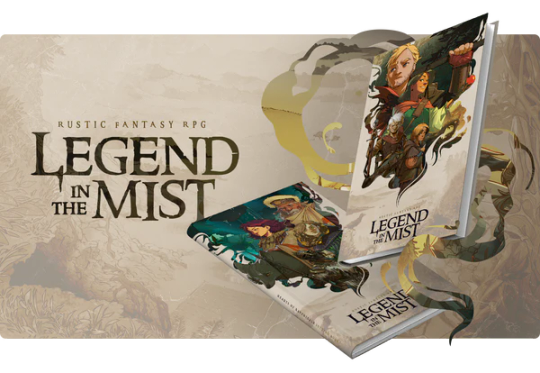
Legend in the Mist is a narrative roleplaying game with optional tactical features, that evokes the feeling of an old fireside tale. You gather your companions, journey through the countryside and wilderness, overcome dangers both natural and ancient, then have campfire conversations about what it all means.
Rather than another D&D-clone, Legend in the Mist focuses on bringing story and gameplay together with each one of its features, from its simplicity at the table to built-in tools for developing personal story arcs for your characters that lead to dramatic moments of transformation
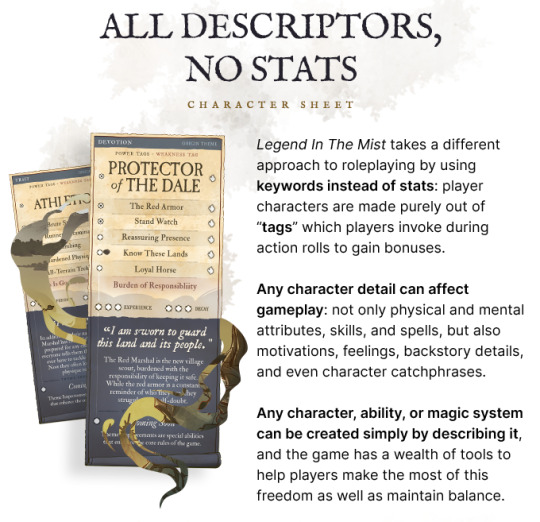

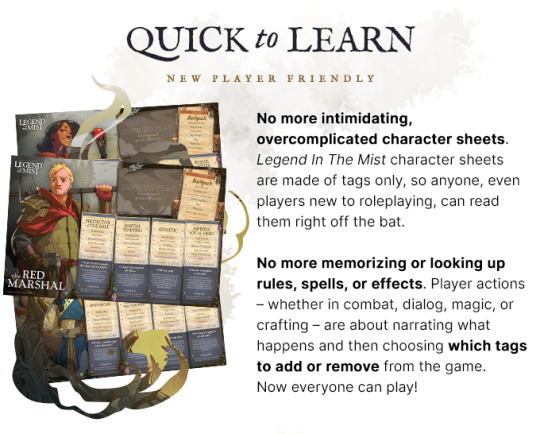
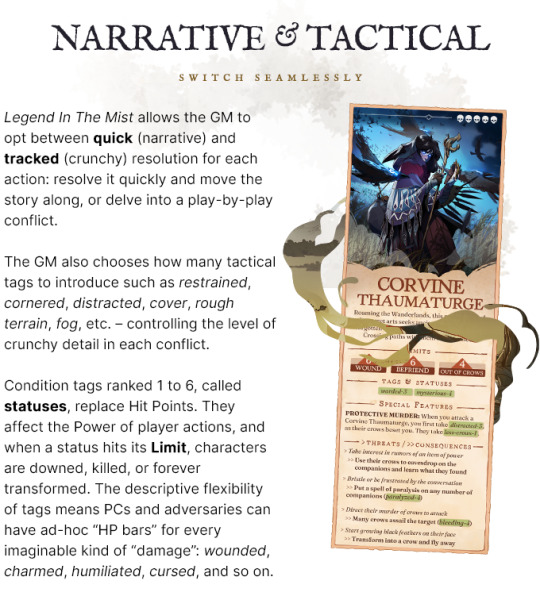
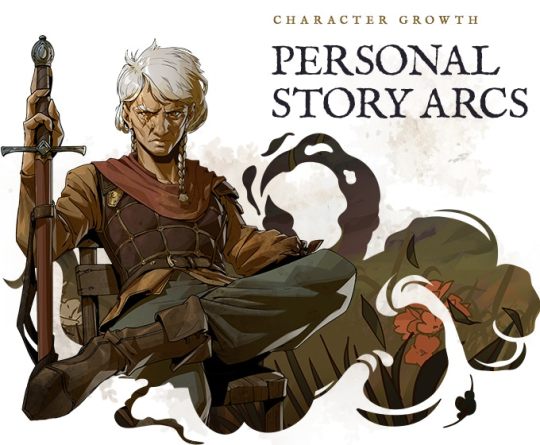
Each PC has multiple and sometimes conflicting motivations that the player must juggle between. Players are encouraged to make hard choices, which can eventually transform their characters in dramatic story moments: they swap out themes and all the tags associated with them for new themes and ability sets, changing the character’s gameplay.
PCs constantly evolve narratively, changing their ���class”, shifting to a new role in the party, or resolving a major backstory event – and coming out of this transformation with newfound abilities.

Uniquely, the game will support a party of PCs of varying power levels, balancing them by giving them equal narrative power (who was more instrumental in Lord of the Rings, Frodo or Gandalf?).
You can start the game with a party that includes a heroic outlander, a powerful wizard, or even a supernatural being alongside a band of rough-hewn villagers whose heroic days are yet to come. This balance between Origin and Greatness themes is at the heart of the game, and player characters can move between these polarities as they progress and change themes.

Legend in the Mist is a setting-agnostic fantasy game that you can play in any of your favorite settings. The Core Book provides you with guides and tools to create any character, culture, adversary, location, or magic system that you dream up!
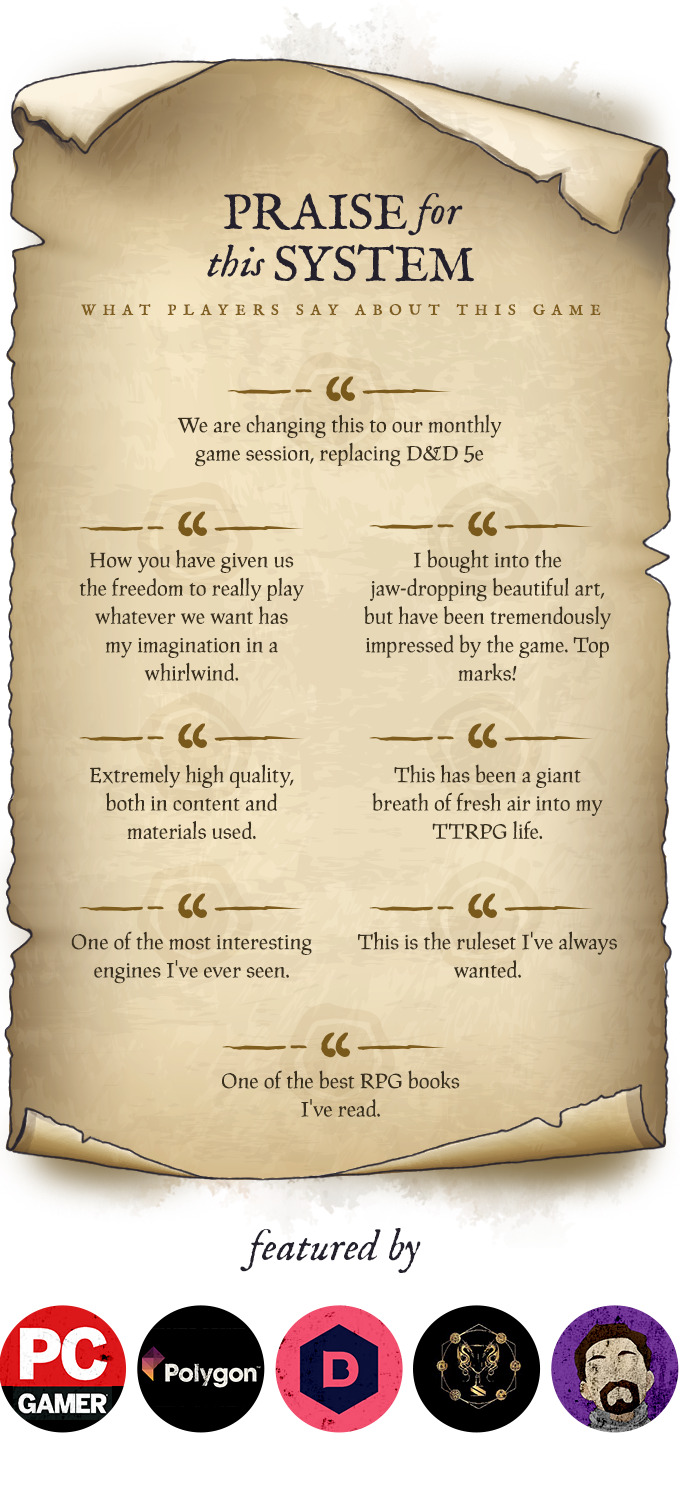
#ttrpg#city of mist#kickstarter#crowdfunding#tabletop roleplaying#tabletop rpg#son of oak#gaming#not sponsored just passionate
94 notes
·
View notes
Text
Baten Kaitos I & II HD Remaster now available for PC
From Gematsu

Publisher Bandai Namco and developer logicalbeat have released Baten Kaitos I & II HD Remaster for PC via Steam for $49.99.
All purchases made by July 17 will be automatically upgraded to the “Month 1 Edition,” which includes a digital art book featuring concept art, character designs, historical documents, and the latest visuals for both games included in the collection.
Baten Kaitos I & II HD Remaster first launched for Switch on September 14, 2023. It includes remastered versions of Baten Kaitos: Eternal Wings and the Lost Ocean and Baten Kaitos Origins, which were originally released for GameCube.
Here is an overview of the collection, via its Steam page:
About
Baten Kaitos: Eternal Wings and the Lost Ocean and Baten Kaitos Origins are now on Steam with improved graphics and new features to aid game progression, making them even easier to play! Delve into the world of Baten Kaitos as you strategize with the unique card-based battle system in these two immersive RPG masterpieces. Play as a guardian spirit who guides the colorful cast as they struggle against destiny itself. A long time ago, there was a great conflict between the evil god and the people. After a fierce battle, the people managed to seal off the evil god, but what was left behind was only a desolate land. The people thus chose to abandon the land and live in the sky. Such fairy tales were passed down as legends. At this time, people had wings called Wings of the Heart and lived a peaceful life. It was an era of long-lasting tranquility… But the collapse had quietly begun. When a young man calls your name, the name of the spirit, the story begins to unfold. A story set on a floating continent in the sky, where thoughts and prayers intersect.
Unique Magnus Battle System
In the world of Baten Kaitos, the true essences of all manner of things, including equipment and items, can be extracted and stored inside cards called magnus. A magnus’ contents can be released at any time, returning the magna essence sealed inside to its original form. These magnus form the basis of the Baten Kaitos battle system. Battles run in real time, so you’ll need to employ quick thinking to select the right magnus for the situation. Strategize against enemies of various elements using elemental magnus of your own, and experiment with mixing and matching different magnus to discover and unlock powerful combo attacks!
Vivid Graphics Remastered in High-Definition
The two titles have been fully remastered in high-definition, including retouched battle backgrounds, character graphics, and user interface. Enjoy Baten Kaitos with even more vibrant visuals.
Aspect ratio expanded from 4:3 to 16:9 for play on wider screens!
Main character and boss graphics have been completely renewed in vivid detail!
All-new menu screens! Enjoy smoother gameplay with refreshed menu layouts, newly added sorting features, and more.
Pre-existing graphics have been used for in-game maps as well as some screens and character models.
New Features for Better Gameplay
Along with improved graphics, the features below have been added to make game progression much smoother!
Auto-save feature
Help menu containing terminology and hints for progressing through the game
New Game+ mode, unlocked after clearing the game once, which starts a new game while retaining all magnus, levels, and ranks
New Game- mode, a mode with level restrictions for an extra thrilling challenge
Six new game system options have now been added, including adjustable game speeds and no-encounter mode.
Save your settings as a Custom Set and turn them on or off at any time.
Watch a new trailer below.
PC Launch Trailer
youtube
#Baten Kaitos I & II HD Remaster#Baten Kaitos#Baten Kaitos II#Baten Kaitos: Eternal Wings and the Lost Ocean#Baten Kaitos Origins#Bandai Namco#logicalbeat#RPG#Gematsu#Youtube
35 notes
·
View notes
Text
It's ZineMonth!!! Lets talk about some cool games!!
There are so many awesome games crowdfunding right now that today we're just going to talk about 10 cool games that are currently crowdfunding on Crowdfundr! I'll be making more posts about more games in the future, and if you know of a cool game that's currently crowdfunding please add it on to this post!!
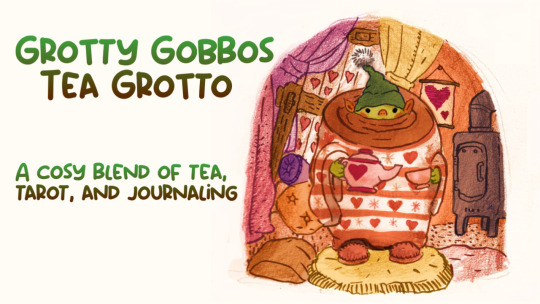
Grotty Gobbo's Tea Grotto lets you take control of the cosy Tea Grotto as you blend tea and build a community around you. Make friends, drink tea, go on an adventure, and stay wholesome.
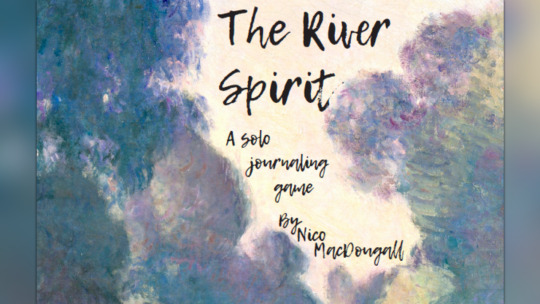
The River Spirit is a guidebook for a solo journaling experience that uses a deck of cards to help you create memories of your hometown and the community found there, only to remix them into new stories and eventually sacrifice those memories for the greater good.

Tangled Blessings is a magic academy horror RPG for 1-2 players that uses tarot cards to reveal your fate.
On the eve of your final exam at Brackroot Academy, what mysteries, secrets, dread, and drama will you recall from your last four years of schooling?
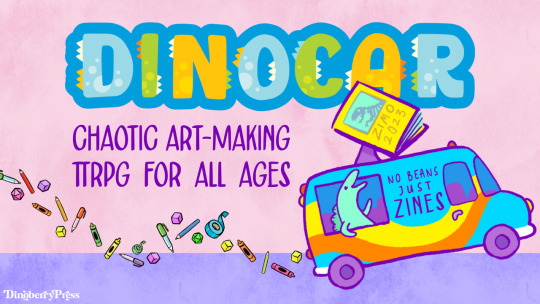
In Dinocar, you and as many friends as you can gather will work together to map out a snippet of that world. You’ll paint a map, draw landmarks, slap buildings into place, and take turns going on chaotic road trips and commutes. At the end of a game of Dinocar, you’ll have a story to tell and a wonderful map to either frame on the wall or stick to the fridge.
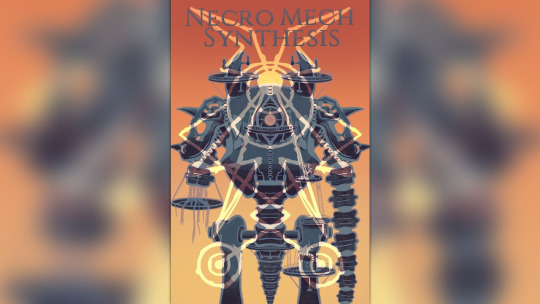
Necro Mech Synthesis is a Bonepunk RPG about ghosts piloting mechs via possession! Fight in a world abandoned by God and defend Lady Death herself against the remaining three horsemen of the apocalypse!
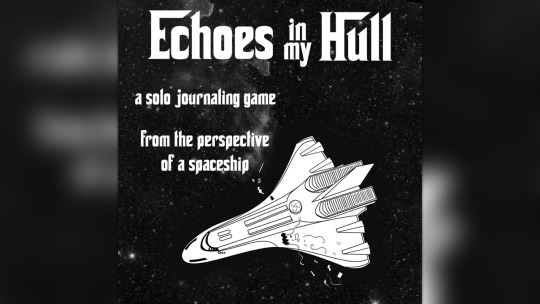
Echoes in my Hull is a solo journaling game about remembering the people we have lost. Use a deck of tarot cards to become acquainted with your crew and ultimately be the last existing record of their lives.

GRANDMOTHERSHIP is a sci-fi TTRPG about senior ladies in space. Get in trouble, crochet a new scarf, go ballroom dancing, and find solutions where everyone else has failed.
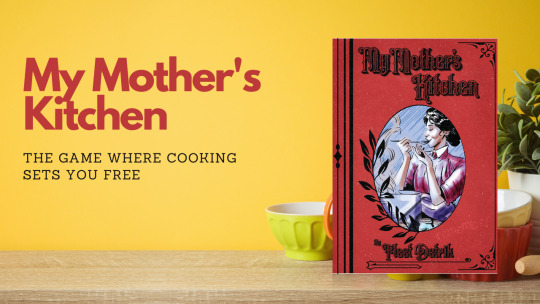
My Mother’s Kitchen is a solo journaling game about traditions, change, and cooking. You play as the author of the original family cookbook, robbed of memory and trapped on Earth as the spirit of your cookbook. Act as a guardian for your family, and try to remember why you’re bound to the book as you guide your inheritors through centuries and generations.

WANDS & LASERGUNS is a high-intensity solo roleplaying game about being a wizard trapped in an anti-magic future. Pit your old-fashioned wits and wondrous new technology against diamond-studded nobility, cybernetically enhanced gangs, dirty cops with a vendetta, and high-fashion psychopaths. The struggle is real when you're far from home.

Derelict Delvers is a thrilling, action-packed sci-fi roleplaying game that immerses players in a struggle for survival and profit. Players take on the roles of elite space troopers, scientists, and engineers who must explore derelict spaceships and space stations in order to scavenge for supplies, salvage for weapons and valuable resources, and ultimately, hunt down the monsters that threaten the very existence of mankind.
Still not enough games? Check out Crowdfundr's Tabletop Nonstop page or the ZiMo official website for more!
449 notes
·
View notes
Text
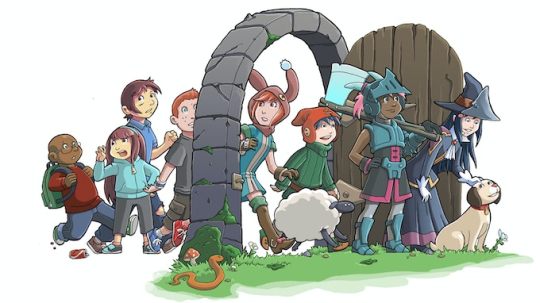
Welcome to Yeld! If this is your first time visiting the Magical Land, you're about to discover a hidden world full of adventures and danger! If you've discovered Yeld before, get ready to continue your adventures with a brand new book full of exciting new options and improvements!
The Magical Land of Yeld: 2nd Edition is an all-ages tabletop RPG with a focus on teamwork, exploration and shared storytelling. Our new edition refines and polishes the easy to learn Yeld ruleset and offers new Jobs, new art and lore, new monsters and plenty of quality of life improvements! Check out our Patch Notes to see what's new in Yeld: 2nd Edition!
Backwards compatible! Yeld: 2nd Edition is fully compatible with all of our previously published expansions. No need to re-buy any of those Job Guides! We appreciate your investment and assure you that you'll be able to continue to use your collection of Yeld expansions!


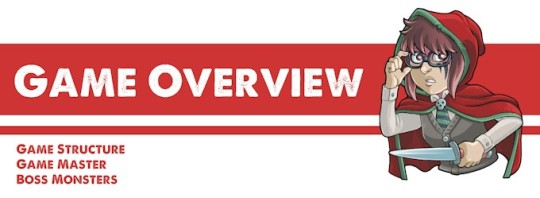
In The Magical Land of Yeld you'll take on the roll of children from our world (called Friends) who discover a land of magic and adventure hidden on the other side of a secret door! Take on heroic Jobs like Shepherd and Witch and set out on a quest across the Magical Land to challenge the infamous Hunters of Yeld and win their keys so you can unlock the door and return home!
But hurry! If you turn 13 while in Yeld you'll become a monster, and you'll never be able to go home again!

In each Yeld adventure the Game Master leads players through a story full of challenges and monsters, to a final confrontation with a Boss Monster! If the players can defeat the Boss Monster they'll collect treasure and Reward Dice that they can use to customize their Friends!
As players continue their adventures they'll be able to take on the Hunters of Yeld. Each Hunter is a powerful Boss Monster with their own unique story, adventure and treasure. Defeating the Hunters awards the players with their Key, and advanced the players to the next Rank. where they can equip their Friends with more powerful equipment and unlock new Advanced Jobs and benefits!
Once the player defeat all 7 Hunters, collect their keys and advance to Rank 4 they can unlock the magic door and return home! Or they can choose to confront the sinister Vampire Prince Dragul and continue their adventures in Yeld!
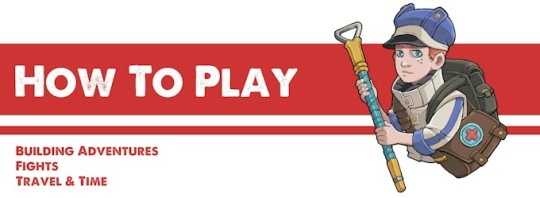
New to Yeld? Download the full 1st Edition Rulebook for free! We're proud of our game and we think the best way to learn about Yeld is to get your hands on it! That's why we're offering the original Yeld 1st Edition rulebook for free! Download it and see what our game is all about! Building Adventures: Adventures in Yeld are a story that you create and tell together. In each game of Yeld the Game Master will guide players through a story. But once the game ends the role of GM will pass to a new player. You'll tell the new GM what you’d like to see in your next game (More sword fights! Explore the Ogre Caves! Learn to cook Snake Cakes!) and the new GM will build a new adventure for you to play, using your suggestions to continue the story where the last GM left off. You’ll take turns as Game Master, making sure each player gets a chance to shape the story. We think you’ll discover that your adventures are more fun because they’re stories we’ve created together!
Fights: Fights in Yeld take place on an 8x8 grid called the Action Board and are similar to video games like Final Fantasy Tactics or Fire Emblem. We've taken inspiration from classic fantasy video games to provide deep turn based, team based action! In Yeld you’ll win fights with teamwork, combo building and improvisation, and every Friend will get a chance to shine! Here's the basics rules for fights:

Travel and time: Time and distance are important in Yeld. As you travel you’ll create a map that will show you where you’ve been and help you keep track of every town, cave and castle you discover. Traveling takes time, so you’ll mark off each day on your calendar. Yeld is full of special Holidays like the Blue Wind Kite Flying Festival and Black Opera Tournament, and if you arrive in the right town in time for these holidays you can participate in special events to gain unique rewards!
You may have arrived in Yeld as children, but each day you'll get older, and if you turn 13 while you’re still in Yeld you’ll become a monster! You’ll take on a Monster Job (like Vampire or Deep Mage) and be stuck in Yeld forever! Your time in Yeld is a race against the clock to see if you can unlock the door home before you become monsters!

Speaking of Monsters... Yeld is full of strange and creepy creatures. Not everything you meet in Yeld wants to eat you, but Vampires, Fairy Soldiers, Mermaid Raiders, Toothfacer Bandits, Tunnel Mummies, Serpent Oracles, Scuba Snakes and all kinds of horrible creatures are lurking around every corner and in every cave, and their favorite prey is young heroes! We’ll be providing a whole bunch of neat monsters for you to choose from, so you’ll be able to fill your fights with all kinds of fun challenges. But our game will also come with a revised Monster Formula, allowing you to easily create custom creatures for your Friends to face!

Lots of comics! We like to present our rules visually. While Yeld features a full comprehensive game text it also has lots of instructional comics to help make learning the rules simple and easy! Plus, comics are fun! Here's a comic about using magic:
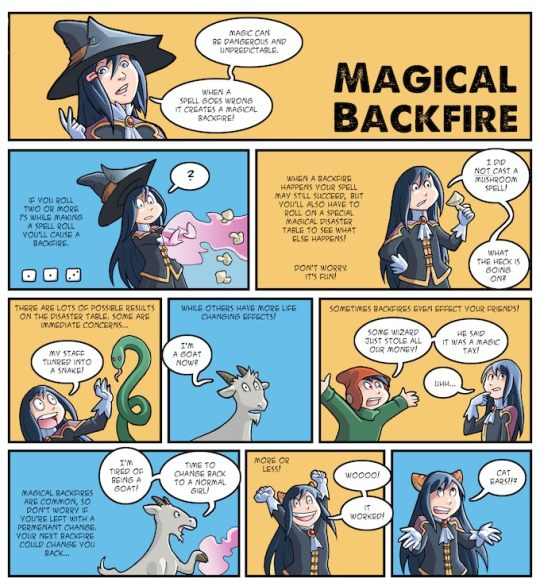

Creating characters in Yeld is an ongoing process that continues even after your adventure starts! Your characters, called Friends, start as normal children from our world. Each Friend is between the age of 7 and 12, and each Friend Type (like Liar, Big Sister or Brat) has a different set of Core dice, Special dice and personality traits. You'll choose your Friend Type and age before your first game.
Once you step through the magic door and start to explore Yeld you’ll get to take on a heroic Job like Witch, Black Mage or Oathbreaker. These Jobs will give you powerful abilities that allow you to face down dangerous monsters and take on difficult adventures. They'll also allow you to customize your Friend with new Core dice and Special dice and new weapons.

As you set out on your quest and explore Yeld you'll have even more chances to customize your Friend. You may decide to switch Jobs, taking some of what you learned from your last Job to a new one. You'll collect Special dice and win Good or Evil dice through heroic deeds or cunning and underhanded acts. You'll discover treasure and trade for loot. You may even go on special quests to learn powerful Advanced Jobs like Vampire Hunter and Drudge Angel! In each adventure you'll have an opportunity to continue to customize and build your Friend!
If you can't escape Yeld before you turn 13 you'll take a Monster Job like Deep Mage and Serpent Oracle. Monster Jobs represent a change in your body and mind as your Friend grows older and becomes more accustomed to Yeld. Being a monster can be scary, but it can also be exciting! Some Friends discover that they love the power that comes with being a monster. And just because you've become a monster doesn't mean you're a bad person. You'll continue to travel with your Friends and help the people of Yeld. Being a monster will just make your adventures more... interesting!
Here's an example: Kiandra starts her adventures as a Big Sister. When she first comes to Yeld she chooses the Oathbreaker Job. She focuses on heavy armor and strong attacks to protect her Friends. Later, she goes on a quest to unlock the Boulder Knight Advanced Job, offering a nearly impenetrable defense to her Friends! When Kiandra turns 13 she chooses the Werewolf Monster Job. Being a Werewolf is a big change for Kiandra. She still wants to protect her Friends, but now when she loses control she can be a danger to them. Thankfully her supernatural strength and furry fury makes the challenges of being a Werewolf worthwhile. And the Special dice she collected as an Oathbreaker and Boulder Knight still help her protect her Friends as a Werewolf!


Yeld is a vast and mysterious land, built on the back of the slumbering Serpent God and harboring ancient secrets. No one knows how old the Magical Land is, and no one has ever seen its edges. The Fairies claim to be the oldest of Yeld’s people, and even they have barely explored Yeld’s secrets. Much of the Magical Land is dangerous wilderness, wildlands where Monsters roam and magic runs free. The people of Yeld make their homes in areas of relative safety, where magical disasters are rarer and Monsters less likely to hunt. Even these territories can be dangerous, and Yeld is littered with the ruins of crumbled cities and lost civilizations. Few kingdoms last long in the Magical Land.

he lands and climates of Yeld are varied. Harsh mountains give way to rainy foothills and plains. Rivers crisscross the lands, intersecting in swampy marshes. Deep forests stretch from coast to coast, and great oceans divide distant land masses. Burning desserts, frozen tundra and even stranger lands can be found in Yeld’s most remote regions. Yeld has always been a place of magic. The Fairies are the oldest inhabitants of Yeld, and they say that when they made their home there they found magic buried deep in the darkest forests and caverns. Some scholars suspect Black Magic is a gift of forgotten gods, all that is left after their magic destroyed them. Others think that all magic comes from the same source, the sacred and unknowable well of power that spawned the great ancient Witches and other monstrous god creatures.
Yeld is the name of the vast Magical Land, but also the name of a Kingdom that lies at the heart of that land. King's People. However, the King’s People are not the only ones who make the Kingdom their home. Fairies, Goblins, Mermaids, Vampires, Squidfolk, Toothfacers, Pi-Rats and the Animal Tribes all live within the territories of the Kingdom, as do other stranger creatures.

The Kingdom is ruled over by its regent, the Vampire Prince Dragul, and a council of nobles, knights, advisors and generals. The Prince and many members of this council are immortal Vampires, and have been alive and in power for over 1000 years since the Prince stole the kingdom from the rightful Princess after the death of the Old King. The Prince’s chief lieutenant’s are the notorious Hunters of Yeld, powerful warlords and monsters who bend their knee only to Dragul. As a reward for loyalty the Prince has given each Hunter control over one of the Kingdom’s territories. Some Hunters have interest in governing, or at least maintaining, their territories. Others have left the lands in their charge to ruin, in favor of waging war or running criminal enterprises such as the notorious Crimson Ministry.
=============================
Kickstarter campaign ends: Sun, February 11 2024 6:00 AM UTC +00:00
Website: [Yeld Stuff] [facebook] [twitter] [instagram]
61 notes
·
View notes
Text
My Thoughts on Persona 2: Innocent Sin (PSX)
I Think my introduction to the Persona series is quite unique compared to other people. Like many I heard about the series from the modern trilogy (3, 4, 5), The first Persona game I had tried was 4 when Golden was released on Steam, but I never completed it at the time.
(I since have completed 4 by the way, I thought it was fantastic!)
However for whatever reason Persona came back onto my radar around early this year right off the heels of me completing Final Fantasy VIII for the first time, gaining a new appreciation for underrated JRPG's. That's when I thought to myself "why does everyone talk about Persona's 3, 4 and 5, But not 1 or 2?" So I did a little digging and found that the Persona 2 Duology had developed a sort of "cult classic" feel to it and that it had one of the best stories in the whole Megaten franchise. (I can't attest to that as I have only delved into the Persona side of the series as of now, but the rest of the series is now on my list of things to complete). I also learnt that the PSP version of Innocent Sin botched the difficulty of the original PSX version, so that's why I decided to play through the PSX version as my first Persona game.

So what did I think?
Overall I thought it was fantastic! However I have some problems with it. So let's start with that.
Demon Negotiation
This was one of the things I was most excited about going into the game, and I think it does a good job at showcasing the characters personality. However the amount of options that the game gives you is overwhelming and makes you feel like you are just guessing when you are not using a guide for contacts, which is what I ended up doing because I got too frustrated with contacting.

(4 options per character, including pairing them up... oh man...)
However I found ways of working around it. If I ever wanted Tarot cards I would end up going to the Abandoned Factory, making a contract with a demon, and then farm Free Tarot from them to use them on whatever personas I wanted. I also ended up using the Prime and Ultimate personas often as they were pretty good while not requiring any fusing.
Overall Slowness
There were many times in the game when I thought that the game felt sluggish. One of them involves the encounter rate. Now listen, I'm a little crazy and I would say I love random encounters in JRPG's and I don't even care about high encounter rates, which this game notoriously has (even though I don't think its that bad), but in the PSX version there is this noticeable pause between getting the encounter and the game putting you into the transition, which threw me off a couple times, but I got used to it. What really bothered me was the lack of a minimap in the PSX version, which as a first time Megaten-er, gave me a sort of hard time. Very often I would have to pull up the map, which took a second or so, but it got annoying quick. What I find particularly confusing in hindsight was that the previous game, Revelations: Persona, had a minimap, so I think its a bit strange that they decided that they didn't need one for the sequel.
(This was also one of those things that was fixed in the PSP version, but I think the PSX version is still worth playing over it, but thats a discussion for another time).
There are also moments in the game that I felt dragged a little bit. Like around the middle of the game after Aoba Park where you go to defuse the bombs around Sumaru in places like Smile Hirasaka and GOLD that I didn't find super interesting. Or places like Xibalba where it just feels like its going on forever. It felt like I was just going through the motions.
Aaaand thats about all the problems I had with it.
"Wait that's all that you had problems with?"
Yup! I think this is one of my favorite RPG's that I have played in recent memory. It's time to talk about what I loved.
The Setting
This is something I think the original Persona trilogy does extremely well, These games have some of my favorite dungeons in any RPG i've ever played, especially the Persona 2 Duology. It reminds me a lot of the MOTHER series in the way that the dungeons are (mostly) grounded in reality with the obvious exceptions. Like one moment you are running around the club and the next you are trying to save kids in an Aerospace Museum. Then you are running up Mt. Katasumuri in the deep forest. Or you are exploring the aforementioned Abandoned Factory with some of the most kickass music ever heard in a video game. Sumaru City as a whole is one of my favorite settings in a videogame.

The Music and Tone
The music in this game is incredible, 'nuff said. Every dungeon I entered I was excited to hear what banger was about to come on and I was treated almost every single time. Sometimes the music is a jamfest like with the Abandoned Factory or Smile Hirasaka. Or sometimes is melancholic and sombre like Mt. Iwato or Aoba Park.
I think the music represents the tone/atmosphere of the game incredibly well. Dark, but with plenty of cool or humorous moments to not make it completely depressing.
Now I don't think that the story of Innocent Sin is the "darkest best story in the whole francise" as many try and sell it to be. But they would be correct in the fact that Innocent Sin definitely has Dark or Sad undertones that make it one of the most emotionally investing stories. Oh I should probably talk about what I thought of the story...
The Story
It's really good, like it was one of the main driving forces as to why I wanted to complete the game. I won't go into spoilers here but all I will say is that I loved the way the game balanced out the serious stuff with a lot of humorous things. The concept of rumors becoming real is such a cool idea and I think they knocked it out of the park, starting with relatively small stuff like "I heard this ramen shop sells weapons", and having it escalate to something being a whole threat to the world, made it really investing.
The characters too, are fantastic. They all feel like family and I couldn't help but care about each and every single one of them. They all have such great chemistry and I loved having them as the party.

One character I really fell in love with was Tatsuya himself, because unlike other silent protagonists like him, he feels like an actual persona and not someone you are just supposed to self-insert yourself into. He has his own personality and past, you learn throughout the story how much he cares about his friends and his determination to protect them all, evident through how he carries his zippo lighter everywhere, which I wont mention the lore significance of. And all of this is not even including his involment in Eternal Punishment where he really gets his time to shine, but this review isn't about Eternal Punishment so lets leave it at that.
Eikichi is a lovable guy and I love his personality (and his weapon is badass too), same with Lisa where I felt her whole romance with Tatsuya was done very well in that it dosen't get in the way of her main personality, I really liked her chemistry with Eikichi.
Maya is a person who I really ended up caring for and I love how she acted as the big sister or leader of the group often, Without going into too much detail, this group really loves Maya and that connection is something I really enjoyed and it made me care about Maya a lot as well.
I also want to use this opportunity to talk about something that I think the Original Persona Trilogy does that's cool in hindsight. They all feel really connected, it's really cool how Yukino from Persona 1 is just a party member again and you get to see how she grew, and just being able to see the P1 cast around Sumaru and how they are doing in life. It makes the world feel lived in, and like every game and the stories in them matter. And that world building is something that I feel like is sadly lacking in the later entries.
Overall this game is worth playing for the characters and story alone.
CUSTOMIZATION!!!!
This will be the last thing I talk about to keep things a little short but I'm just going to say that the customization in this game is some of the most fun things about it.
The fact that everybody can change their personas is MASSIVE and SO MUCH FUN.

I often found myself thinking "OH! If i fuse that guy I could do THAT fusion spell, or I could get THAT spell that would be really good"
And the fact that they can swap personas ON THE FLY gives me a customization rush that I haven't felt since playing with Final Fantasy VI's Espers or Final Fantasy V's Jobs.
I could swap a character from being a healer to damage dealer or debuffer and there was no limit to how I could do it. It was fantastic.
And Im gonna use this oppertunity to talk about the combat because in the PSX version I find that it's really smooth and fun to do once you get the hang of it.
And Fusion Spells are such a cool mechanic, it reminds me a lot of the Dual and Triple Tech's in Chrono Trigger and I was all for it!

And of course, shoutouts to Nova Kaiser being one of the coolest spells in and RPG, its so satisfying to use.

Conclusions
I love this game, and I couldn't think of a better way to be introduced to the series. After I beat Innocent Sin I immediatley went and beat Eternal Punishment, and then Persona 1 right after that.
The Original Trilogy is something that I think deserves to be remembered and praised, as they are magnificent games that I think unfortunatley are not as accessable to a general audience.
But I implore to whoever cared enough to read this to give it a shot.
I do think that the PSX version of Innocent Sin is the best because the PSP's botched difficulty is not the only problem I have with the port. The menus feel awful to go through, and I feel like Atlus knew that too and fixed it with Eternal Punishment PSP and made it more like the PSX menus. But at the end of the day IS PSP has a better translation, more quality of life, new bonus content and remastered music which is also pretty good, so whatever version you prefer is the best version.
So Please give Persona 2: Innocent Sin, and the rest of the Original Trilogy a shot, you might find a gem and a new incredible JRPG that you never knew you would like just like I have.
14 notes
·
View notes
Text
Chapter 1: Meeting the Heroes
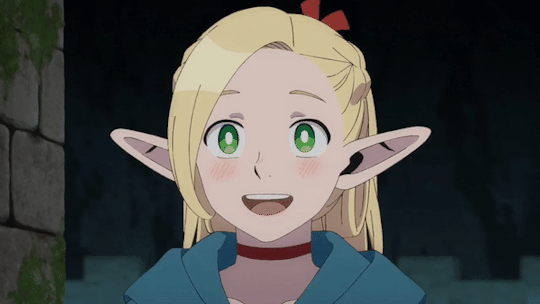
Modern times:
Y/N was leaving the local bookstore, they had finished their shift at and were leaving the store with some of the books they had picked up, mostly fantasy but some cookbooks. As they were crossing the street not really paying attention to their surroundings, their mind was preoccupied with thoughts about what to make for dinner. They were busy drooling at the thoughts of food that they didn’t see the truck coming at 90-miles hour with no chance of stopping.
Waking up:
They woke up in a stone room, “Ugh my head what happened, I remember walking across a street and loud screeching sound then...” Y/n pondered out loud. They proceeded to look around, “It’s very dark.” Pulling out their phone to get some light, they look around the room and don’t really see all that much, but they find a mace, “Cool this looks like the ones in movies.” They beamed, running their hands over the spikey bits before taking it. Y/N finds the bag that they had on them before the accident; they went to pick it up when the phone went off. They looked at the phone and saw a new app appeared on their phone Dungeon Inventory, “What is this app, I don’t remember downloading it.” Y/n pondered out loud, “It goes against my better judgment clicking on random apps, but I have no idea what is going on.” They proceeded to click on the app.
Welcome to the Dungeon Inventory app! This app is a link to your bag that you picked up, it will give you a detailed description of the items that are in your bag. Warning: your bag cannot support life, refrain from putting living creatures in this bag.
List:
1 set of clothes
2 weeks’ worth of food
1 Blank journal and pen
1 taser
1 first aid kit
1 A Dungeon Explorer Adventure (fantasy book)
1 Cook with what you Have (cookbook)
“What a weird app.” Was the only thought they could think of. Y/N backed out of the app and see 3 more new apps: Dungeon GPS, Dungeon Status & Creature Guide. Y/n thinks about what they should do, if they should open another sketchy app on their phone, they go ahead and hit the app Dungeon Status.
Dungeon Status App:
Welcome to Dungeon Status, this app will keep track of your well being and spells that you can do.
Y/n proceed to scroll down and see what looks to be a character sheet from an RPG.
Y/N L/N
Race: Human or Tall-man
Description: a human that as no idea where they are or what happened
HP: 20/20
MP: 30/30
Spells:
Light: a ball of light will follow the caster
Spark: can produce a small flame
“Whoa I can do magic?” Y/n said out loud. Y/n clicks on the light spell and how to produce the light ball. Y/n constraint hard thinking about the ball of light that then said the word “Glow” and a small orange light ball appears in front them.
“Whoa neat!!! I can do magic!” Y/N said excitedly. Looking back at their status the MP went from 30 to 29.
“Ok I need to go find someone that can help me figure out where I am.” They pick up the mace they found, gave the room one more glance to see if there was anything else useful and proceeds to the door.
As soon as they open the door and peeked outside Y/n hears a *ding* they look down and see their phone lights up with a new app on the screen Dungeon Map. Y/n looks at it and thinks to themselves this looks like a mini map from a game.
They are represented as an orange dot, and they see a blue arrow point to the left hallway. Thinking that their phone hasn’t lied to them yet, they proceeded to head down the hallway to where the phone was taking them.
Hallway
It hadn’t been a few minutes walking down the hallway with the only comfort they had was the orange light ball accompanied them, when Y/n heard a noise. Getting nervous they shuffled up to the corner wall to peek around the corner to see what the noise was.
Looking around the corner Y/n sees a group of adventurers getting their butts kicked by… a walking mushroom? While the mushroom didn’t look particularly strong, it was strong enough to take on 4 adventurers.
After one of the party members fell the adventuring party gathers them up and makes a hasty retreat screaming as they are being chased by the mushroom creature.
Y/n takes it upon themselves to sneak up behind the mushroom creature, making a noise so that the mushroom would turn around and see them. Y/n showing that they are not hostile the mushroom just stands there before walking over and circling them.
Y/n taking note of this mushroom, it was purple with green spots it didn’t look like it was going to harm them. Y/n then hears a ding from their pocket. Taking out their phone they find a new app was unlocked.
Howdy there Welcome to the Dungeon Creature Guide!
This app will keep track of all the critters and monsters that you would come across. Take a picture of the creature to get more information!
Looking at the phone then back at the mushroom, Y/n was about to take a photo of the purple mushroom when they heard a noise from down the hall where the adventurers had fled.
There they see a tall blond guy deck out in armor, then they see a girl with long blond hair with a halo staff, and finally a short boy with a green scarf.
The purple mushroom now hiding behind Y/n when noticing the new people.
“Hey, do you need help with that monster?” called the blonde girl.
“Why aren’t you fighting it?” asked the short boy.
“No, I am fine, this little guy has done anything wrong, and I was trying to get more information about it before deciding what to do.” Answered Y/n.
“What do you mean, it’s a Walking Mushroom, it’s a basic monster?” said the small boy placing his hands on his hips.
Y/n thinking what to do next weighed their options, they are the first people that they came across that looks halfway friendly. So, they may be the best option to gather information on their whereabouts.
“My name is Y/N L/N, I woke up here and I have no idea how I got here or where I am. I remember leaving the place I worked and crossing the street.” Y/n said to the three adventurers.
“How can that be?” the blonde girl said, “No one can wake up in a dungeon?”
The short boy adds the conversation “What are you wearing? That’s not really going to protect you from monsters and bandits in this dungeon.” The short boy looks at Y/n clothes with interest.
Y/n was wearing blue jeans and a polo black shirt and a pair of purple sneakers.
The three adventurers huddle together discussing about the situation.
“They must be lost, or they got kidnapped and dumped here, can we really leave such a person by themselves?” said the blond girl. “We have a mission Marcille, can we honestly bring them with us to fight a red dragon?” said the short boy. Both people looked to the silent member of the group who Y/n assumed was the leader of them. “Laios what should we do?” asked Marcille.
Laios walks over to the Y/n and stares at them, “We are on an important mission to save someone from a red dragon, do you want to join us?”
“I am not much of a fighter, and I don’t know where I am and how I got here. But if I go with you, I might find answers. So sure, I guess I ill tag along.” Y/n stated bluntly to him.
“Great my name is Laios, the blonde elf girl is Marcille, and the other guy is name Chilchuck.”
“Oy don’t go telling people our names!” scolded Chilchuck.
Marcille looked pleased with the outcome, the more people that can help with their quest the better, but she does have some underlining worries about having an inexperience member on the team.
“Wait what are we going to do about the purple mushroom?” Chilchuck said but then he notices that the mushroom had escaped while they were talking.
“Well, we already got a red mushroom from earlier, so I guess its fine if we don’t go after it.” Laios mused.
“Why do we have to eat monsters?” whined Marcille “Why can’t we find birds or fruit in some of the lower rooms?”
Y/n remain quiet while they observe the group bickering about eating monsters. Y/n, from what they gleamed from the conversation, learned they were in this dungeon earlier with three other members, but they were attacked and one of their party members got eaten by a red dragon. The other two members of the group quit because they needed to earn cash and couldn’t go on with this group anymore.
So, Laois is hell bent on finding the red dragon as soon as possible to recuse their missing member and not wanting to take a trip up to the surface every time for food, Laois gets the idea to eat monster, so they get back to their missing party member quickly.
Setting up for a meal:
As the group proceeds to a common area where a lot of adventurers meet up and take a break, Laois leaves the group for a few minutes looking for something, Chilchuck is grabbing some water from the fountain.
Marcille finds a spot to for the team to take a break, Y/n decides to set a small campfire, they wanted more practice with their magic so taking out their phone and scrolling to the Stats app they find the spell and reads the directions to get the spell “Spark” going.
Spark: simple point to the area where you want the flame to be and say the word “Ignis”.
Y/n not really believing that this was going to be that easy, did what the directions said, and small orange flame shot out from their fingertip.
Y/n looking at their fingertip, and the campfire and then back at the phone then simple mutters “I am god.” With a smile on their face.
Marcille then chimes in “I didn’t know you were a magic user?”
Y/n turns to Marcille and explains that they weren’t till they got here, and they still have a lot to learn about magic.
“What’s that thing you were looking at?” Chilchuck came back from getting water setting the pot on the fire.
“This is my phone, when I woke up here a bunch of apps appeared on it that weren’t there before, but they are useful, and it is showing me the spells that I can do to.” Stated Y/N “Basically think of it as a spell book.” Summarizing the explanation when Y/n saw both Chilchuck and Marcille looking confused, but Marcille looked happy with the explanation, while Chilchuck still looked a bit confused.
The awkward silence came to an end when Laois showed back up with a scorpion.
Meeting 5th new member:
Marcille was still fighting the fact that she didn’t want to eat monsters and was questioning Laois every step of the process. Laois said that his book said that the scorpion was safe to eat and not to worry.
After taking a bite of its tail, he was feeling sick.
“Hang on minute!” called a voice. The group turned to see short hairy man with an axe and black pot strap to their back.
“You’re cooking it wrong.” Said the short man. The man took over and showed the tasty bits of the scorpion that were worth cooking and how to prepare it.
*Ding*
Y/n looked down at their hand to see a notification on their phone.
HI Welcome to the Quest app. This app will help you gain experience and will give you reminders on what needs to be done.
So, your first mission is to help Senshi make the dish Scorpion Hotpot.
Find these things listed below to make the dish extra tasty. Also check your bag for some spices.
“Ok” thought Y/N “How did the phone know this guy’s name before he even introduced himself.” Y/n and thought to themselves maybe not tell the party just yet that their phone has information that hasn’t been disclosed just yet.
Y/n open their inventory app and saw some salt and pepper was included in their bag. Y/n reaches into their bag looking for the seasonings and pulls them out.
“Um… hey I have these, you can use them in the hotpot?” offered Y/n, handing the salt and pepper shakers over to Senshi.
“Thank you these will help.” Senshi nodded softly in thanks.
Y/n looked down at their phone and started look for some herbs growing around the cemetery “Does this count as disrespecting the dead?” Y/n wonder to themselves. Y/n found a root looking plant. “You have a good eye.” Y/n turns around to see the dwarf. He takes out his knife and cuts a bit of the root looking plant and gathers up some other nearby plants.
*Ding*
Y/n looks down at their phone.
Congratulations on your partial success. Check your inventory for your reward!
Y/n scrolls over to the inventory app and sees a crossbow and some bolt ammo for it.
“Neat.” Thought Y/n. They made their way back to the group.
Senshi was going through the process of cooking the ingredients, Marcille, at one point was trying to persuade the group once again from not eating the dish since the plants were harvested at the grave yard.
Laois was trying to get her attention. Y/n notice some green goop falling from the ceiling right above Marcille. Y/n quickly grabs Marcille wrist and pulls her out of the way.
Marcille face turn pink when Y/n had pulled her out of danger. Senshi quicky made short work of the goop.
Y/n thought this was good time to snap a picture of the goop.
The Creature guide
Green Slime: they like to suffocate their prey. Much like Walking mushrooms these creatures are easy to take out.
The app also brings up some stats and a diagram of a slime.
Chilchuck seeing Y/n looking at their phone goes over and takes a look and sees the diagram and a bunch of words that he couldn’t make heads or tails on.
Senshi then presents the dish Scorpion hotpot. The dish looked amazing, and Y/n, falling into old habits, takes out their phone and snaps a picture of it.
“What did you do?” question Chilchuck, while Marcille, Laois and Senshi looked on. “Oh, sorry when I see a tasty meal I take a picture of it for food journal.” Y/n answers.
Y/n then proceeds to show Chilchuck some of the amazing looking food that they had eaten before.
Chilchuck takes the phone and Y/n shows how to swipe to get to the next picture. Senshi proceeds to introduce himself to the party and finally Marcille joins in eating the food. Laois, Chilchuck, and Senshi were looking at the pictures on the phone drooling over the pictures of food.
Laois then tells Senshi their quest that they are looking for a red dragon to save their missing party member and Y/n needed to find answers on where they came from.
Senshi looked pleased on hearing about the dragon, and he did seem interested in Y/n’s quest.
After cleaning up their campsite Senshi agrees to join the quest.
*Ding*
Congratulations! You have joined an adventuring party, and you also gained a new ally. Your reward is 1 new spell and you gain a santoku kitchen knife.
#fantasy#adventure#delicious in dungeon#dungeon meshi#senshi of izganda#laois touden#marcille donato#chilchuck
26 notes
·
View notes
Text
Hey you! Yes, you! Learn how to use GZDoom!
Also if you see this post, please reblog it if you think it's good, like I don't think Tumblr's algorithm (that kinda exists) will like it.
Hi, I'm Lynn "WJB" Beck, and I'm here to tell you about an exciting new old game engine that is extremely easy to use for not just making original games, but also mods and animations and stuff!
And this engine... is GZDoom.
GZDoom is an enhanced sourceport of the 1993 first-person shooter, demon-punching simulator and stress-test for pretty much any technology that contains a computer. As opposed to more low-key and/or "vanilla" sourceports like Chocolate Doom or Boom, GZDoom allows for a lot more options, including Build Engine-style voxels, several types of dynamic lighting, and even stuff that was originally exclusive to specific Doom Engine games, like Strife's light RPG mechanics, This means that it can be used to make extremely impressive "total conversion" mods, and even fully original games with entirely custom stuff!
This guide covers how to get started, and a basic overview of how certain things work (get ready to learn about lumps!).
Getting Started
Ok so before you can start Doing The Thing, you need to... install some software! Don't worry, it's only like 4 and they're fairly lightweight.
Go to this website here and download the most recent version of GZDoom. You will need this to actually run your game.
Go here and get Slade. You will need this to import custom graphics and audio, as well as to use text-lumps (which are basically necessary, even if you're making a basic custom level set, and I will explain why further down).
This ZDoom Forum topic is where you can get Ultimate Doom Builder. While there are other Doom mapping tools, UDB is what I personally use, and it's extremely beginner-friendly while also being fairly versatile. It even has a built-in script editor, so you can modify a script and then immediately jump into testing to see if what you've done has worked!
Finally, you need a copy of specifically Doom 2. You could use Doom 1, but in my opinion Doom 2 is better because it has a lot more stuff than the first game, and - let's be real - you'll probably be doing a lot of vanilla mapping to get to grips with the editor before you can start making your big ambitious game (which is what I'm doing over on my modding sideblog, check it out). I'll leave this one up to you. EDIT: I forgot that Freedoom exists. That's also good.
Mounting stuff into Ultimate Doom Builder
Next, you'll need to get UDB set up. This is fairly easy. First open UDB and, as soon as it starts up, go to the top-menu and click "Tools", then go to Game Configuration. Select "GZDoom: Doom 2 (UDMF)" and click "add resource"; using the attached file-explorer, locate the Doom 2 folder on your computer's file system and add DOOM2.WAD to the list of resources, then do the same with gzdoom.pk3 in the GZDoom folder (making sure to switch the "Add Resource" tab from "From WAD" to "From PK3". Click Ok, and you're done!
If you want to put your custom graphics into the game, you simply create a WAD file in Slade, put your graphics in (more on that later) and save it; then when creating a map in UDB, this box will appear:
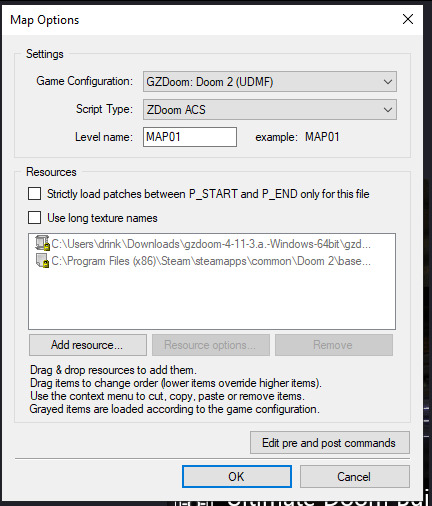
If you click "Add resource" here, you can then select your custom wad and use any assets, code etc. in your map!
How Slade works
This bit is a bit more complex because it deals with multiple file formats and methods of importing stuff, but I'll start simply by explaining textures, flats, sprites and patches.
Before I do that though, I need to talk about Markers. To define images as a sprite, patch or flat, you need to put them between a pair of Markers with specific names, which you can create by clicking the "New Entry" button:

"Empty (Marker)" is selected by default, so all you need to do is name it. The naming format is [LETTER]_START to start a section and [LETTER]_END to end one; S_Start/S_End are for sprites, P_Start/P_End are for patches, and F_Start and F_End are for flats. You can, additionally, further subdivide this by making another pair of Markers inside a Start/End pair with a number after the letter, but I'm not sure if this does anything (my only experience with it is that the Doom 2 wad file does this).
Now to explain how these things actually work! First, sprites. A sprite is an image that represents an object or creature in the game, and a cool thing that GZDoom does is let you use generic PNGs instead of Doom's proprietary GFX format. Sprites use the following naming scheme: a four-letter identifier, a single character denoting what frame of the animation the image represents (the Arch-Vile, which has the most sprites out of any monster in Doom 2, has frames that go from A all the way to Z, and then [, \ and ]), and finally a number from 0-8 that indicates the angle the Thing (that's the technical term for a Doom Engine entity, by the way) is at. Using the Imp as an example:

The "0" angle just means that the sprite should look the same regardless of the player's angle; this is used for items, decorations, the death animations of all monsters (including players), and the two sprites used for Doom II's final boss.
A cool thing about sprite angles is that you can actually make a sprite work for multiple angles; by adding an extra frame-letter and angle-number after the first set, you can do things like have a monster whose left and right walking frames are the same but mirrored by formatting the sprite's name as something like NAMEA2A8 (in fact, the Imp uses this technique for all its sprites apart from its death animation).
Next up, flats! Flats are square textures that are designed to go on floors or ceilings (though you can use them anywhere, including as sky textures!) but lack the flexibility of patch-based textures. You literally just. Import your texture and put it between F_Start and F_End. That's it. That's how a flat works.
And finally, patches. Patches are complicated, but very easy to use when you know what you're doing. First, put your image between P_Start and P_End, then right click it, put your mouse over the "Graphics" dropdown, and select "Add to Patch Table". You will then be prompted to create a TEXTURES lump; click "Ok" with the default settings. This creates a Texture1 lump, and the "Patch Table" (which is just a list of patches, which I will explain soon), alongside P_Start and P_End if they aren't already present (and a dummy texture). Double-click Texture1 to open it, and then select "New Texture" (you can adjust the scale, too):

Once this is done, go to the top-right corner and click "Add patch":

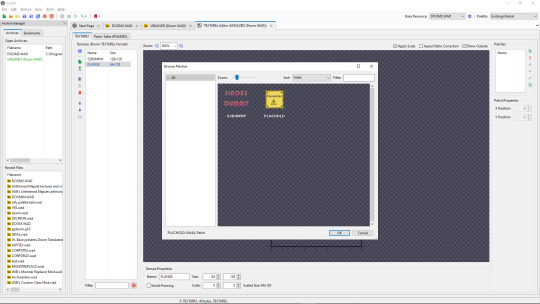
By default, you only have access to any patches you have assigned, but a cool trick I use in my own mapsets whenever I want to modify an official texture is to copy its Texture1 entry from the Doom 2 WAD, then paste it into my WAD's Texture1 and rename it. This does create copies of the constituent patches in your own wad's P_Start/P_End section, but you can delete those and it will still work fine.
Both patches and Flats are limited to 8-letter names, so be warned.
The actual final thing to talk about is converting PNGs to GFX; this is a simple process, but it can cause issues with colour. Basically, Doom has a very specific palette:

While this can look pretty good, on images it wasn't designed for or that use colours it doesn't feature, it can look pretty bad. For example, if I put this random image I made through the conversion process:

Then it comes out looking like this:

All the more cyan-adjacent hues become more blue, it nuked the antialiasing, and some of the gaps in my colouring are now much more obvious (especially on the fifth character's head and legs).
My point is, only do this if you want your mod to be compatible with more vanilla sourceports, or if you want to reduce the filesize. Otherwise, you're better off just using a strict palette when making the sprites and keeping them as PNGs.
Custom palettes are possible, but like. Literally all you do is click "New Entry", select "palette", name it, click the "Import from" button (purple page with a diagonal arrow on the top-middle of the palette-view window), set the filetype on the file explorer to "PNG", and import your custom palette image (which should be square (non-square images get squished and lose some colours) and 16x16 at the smallest, though the images I normally use are 128x128 because for some reason they're scaled up by a factor of 8, even though they display the same when imported regardless of size). You can even test them out or add them to the in-built palette list, which is nice. If you want it to override the default palette when your WAD is loaded, name the lump "PLAYPAL", which is what Doom's palette is called.
Now we get to talk about text lumps! I don't have much to say. Do the "New Entry" thing, select "Text", and name the file. The ZDoom wiki - which I will be linking to at the end - has information on each type, so check those out.
Map making
This is the final main section of this, and I'll try keeping it fairly brief and simple. Doom maps use four main elements; Vertices, Lines, Sectors, and Things. A Vertex is, well a vertex; it's a point in 2D space that acts as a starting or connecting point on a Line. Lines can be either walls or walkover triggers, depending on how you use them. Sectors can be rooms or shapes on the floor, and have properties such as damaging floors, being "underwater" (the player can swim and sound is muffled), or even having different gravity. Finally, a Thing is any entity that isn't one of those, ranging from monsters to player-starts to decorations, plus some complex technical ones I can't even begin to explain.
Useful resources
I am not good with words, but these places are!
ZDoom wiki - covers both regular ZDoom and GZDoom, plus other sourceports like the multiplayer-focused Skulltag and Zandronum. It has guides about ACS and ZScript, two of GZDoom's most useful tools for scripting maps and Things, respectively, as well as the obsolete "DECORATE" language which ZScript incorporates many elements of.
Dragonfly's Doomworks - mapping tutorial resource. I use their portal tutorial a lot whenever I want to put portals in a map.
Doomwiki - good for looking up monster and weapon stats for if you're making custom Things.
23 notes
·
View notes
Text
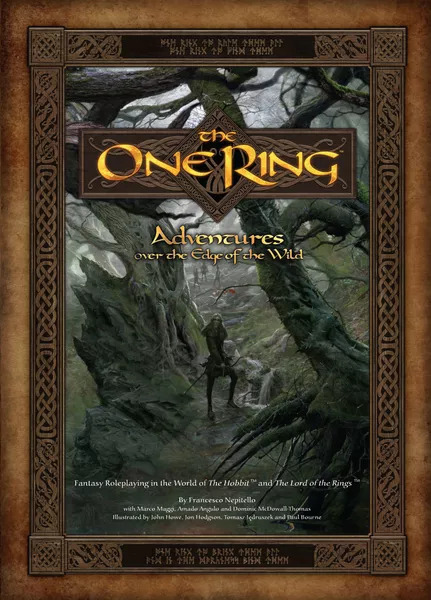
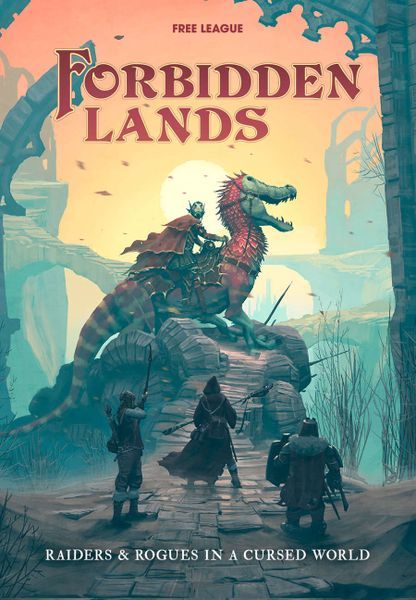
Journeys: Great RPG Mechanics #RPGMechanics: Week Five
In Playing at the World Jon Peterson mentions the impact of the board game Outdoor Survival (1972). It influenced early D&D– framing the act of crossing wild distances as an adventure unto itself, with perils beyond monsters. This theme appeared in several early board games– traveling out into a blank map, filling it in, and dealing with random events (Source of the Nile, Magic Realm, The Mystic Wood). The third booklet of original Dungeons & Dragons, “The Underworld & Wilderness Adventures,” specifically references Outdoor Survival and using it in play.
So, while dungeons have always captured the imagination, travelling through great spans has always been a close-run second. The popularity of hex-crawls and point-crawls, moving through unknown space, illustrates something basic. There’s no functional difference between different spaces and locations within a game. A dungeon, in terms of motion through it, mechanically operates like a forest or a city. The party moves through a space and arrives at an event. There’s some description possibly of the passage, but functionally it is the same.
The difference lies in the trappings and mechanics: time, obstacles, physicality, travel resources, etc. There are some meta-considerations as well. I remember running a city-based campaign which had a set of maps I’d drawn of different neighborhoods and areas. I had a player complain that he wanted a traveling campaign, to see different things. I explained that the city was varied and interesting– going to other places and neighborhoods could be just as cool. We went back and forth as I tried to drill down on what he wanted.
It eventually came out that he wanted a game where his character could loot, destroy, and shit on folks and then move on. Having a game in a city meant he’d have to deal with people and potentially suffer consequences.
In any case, if time and distance function mechanically the same across different sizes and instances (dungeon, wilderness, city), how does a game differentiate? The most common tool has been random encounters– with chances varying based on the terrain. Different environments have different appearance rates. That’s an approach ubiquitous to early FRPGs. That might then be elaborated with guidelines for speed, exhaustion, weather, supply, and encumbrance. The level depends on how crunchy the game is. In fact these kinds of systems have been a hallmark of trad approaches.
So it was interesting to see a more modern, story-driven game take a swing at travel and work to integrate it into play. The One Ring (with the original subtitle of Adventures over the Edge of the Wild) aims for this. TOR has some trappings of the trad game, like Encumbrance but handled simply. It has the need for a map and the calculation of possible distance and travel time. Resolution here goes through setting route, judging distance, multiplying by terrain, and comparing that to speed. That generally determines the number of fatigue tests being made.
Those tests are made by the traveling companions, with each having a different role. We have the Guide (making decisions), Scout (setting up camp), Huntsman (finding food), Look-out Man (keeping watch). Journeys have a set procedure beyond fatigue tests with players carrying out their role and comparing it to a hazard target, with different events possible.
Forbidden Lands takes a page from TOR, echoing this procedure. It falls somewhere between Mutant: Year Zero’s zone exploration and TOR’s role system. In practice it feels a little more mechanical and wearing than a Tolkien-esque journey. Forbidden Land’s travel can be brutal– that’s a feature of the base game system. The land is supposed to be harsh, newly opened after a post-apocalyptic calamity. In that sense it works, but in play it can seem absolutely punishing for players who don’t expect it. I definitely want to explore travel in play– with something more than just an Undertake a Perilous Journey move. In theory I love the idea of a deep journey procedure, but neither TOR or FL exactly hit what I want. The former feels like too much calculation and too many rolls potentially and the latter like a procedure for beating down the player’s resources. I love the idea of Journey mechanics, but I want something which falls in the middle of those– offers interesting play, adds to the story, and feels like the sweeping grandeur of crossing great distances.
58 notes
·
View notes
Text
MOD: 7th Stand User: R
Download it here: https://drive.google.com/file/d/1mN49EvprHEzvJmUvwvQvUEidZF17aubk/view?usp=drive_link A QoL mod of 7th stand user, based on version 2.6 with the colors from DX! Some gameplay elements have been altered to make it a bit more accessible for those that are not into old-school RPG's! If changes some aspects of the game that some players find frustrating, such as random encounters. This mod focuses on QoL and does not add new events or story elements.
Features:
• Colors from DX! HUGE thanks to Pythagasaurus13, the creator of DX, for letting me use these. Note that some colors have been adjusted a bit, generally to make it easier to tell different characters apart. • Water tiles no longer have a "flashing" effect and the screen flashing effects of certain battle animations have been toned down. • No random encounters. All enemies appear as characters on the map now! (The only exceptions are Caravan's pocket dimension and the Debug Room.) • Skills that can only be learned from staying at a hotel will now longer unlock randomly. Instead, they are guaranteed to be unlocked if you meet the requirements. • Several endings now allow you to enter the Dev Room: Betrayal End, Mad World End, Good Josuke End and the Unrest End. • Items show you how much HP/SP they restore. • XP gained from staying at hotels has been rebalanced. • Food (the type that can't be used in battle) will heal the K.O. status. Additionally, food at hotels now recovers a bit more. • Option to do a "fresh start" rather than a new game+. This is very similar to just starting a new game, but you keep your completion counts and special unlocks. • A whole bunch of bugfixes. (And maybe even some brand new bugs 🙃) • More small adjustements that are not listed here! Q&A Q: I already have a save file, can I use that? A: Yes! Just copy your save[number].lsd into the 7SU-R folder. But make sure to back up your original save just in case. Q: Does it work on EasyRPG? A: Yes! Q: I found a bug, eediot. A: DM it to me! I'll fix it. Don't be afraid to mention small graphical errors either. Q: I have a suggestion! A: DM it to me! But keep in mind: This mod does not aim to add new content and I do not want to change character dialogue. (Unless you believe something is mistranslated) Q: Can I still use the wiki? A: Most of the guides on the wiki will still work for 7SU-R, but a couple of details might be different.
Q: Are the Chaos Mode / Ballin' updates included? A: Yes, thanks to KKM's help, the mod is currently up to date with 2.6's Ballin' update. Q: Is the story any different? A: Nope! There are only some spelling errors and a couple of minor dialogue changes to reflect the QoL changes.
Q: The game is stuck in a tiny frame in the corner of the screen. A: If your screen is only in the corner then right click the application and then go to properties. Go to compatibility and then click Change High DPI setting. At the bottom it will say Override high DPI scaling behavior. Click the check box and make sure what's under it says application. Then restart the game.
Q: I have another issue... A: Check the FAQ on the 7th stand wiki.
Credits: Clayman for creating 7th stand user. KKM for creating the 2.6 translation as well as YellowCardinals & MaudDuke for creating the earlier translations. Pythagasaurus13 for coloring DX. The 7th stand wiki Discord for helping with testing, especially BreakDude who picked out a ton of small errors.
135 notes
·
View notes
Text
Devlog 20/08/2024 - Travel game idea that will probably change with time but I felt like sharing cuz it's 10 p.m. and I'm not sleepy yet
Since I'm traveling now and dropping zines as I go I've been inspired to create eventually a traveling themed TTRPG. I'll take my experiences during this train trip in europe as inspiration and learning material for this future game.
The idea I have is for a large project I call fantasy tourist, a game about traveling in a fantasy world. The base mechanics are simple. You have a buget for each town, you can stay for as long as you have money. I also wanted to add the fantasy adventure element of being allowed to take small jobs to increase your budget and stay in a town you liked for longer.
The reason this would be a large project, is that I wanted to properly write town guides. I wanted this to be a little bit more guided than my usual solo rpgs. Yes, imagining yourself is part of the fun, but I want this to feel like a choose your own adventure book in a way. I want you to feel like these places exist already and you're exploring them.
In my ideal version of this game each town guide would have:
Budget – depending on your character and other factors the budget you have on each town may change. I'll also add a dice roll for a little bit of fun randomness.
Overall description – this is just a description of the town you’re in and what is known for.
Attraction guide – this is the list of things you can do and see in this town. Some attractions also come with guided tours, if that’s the case it means you’ll get a detailed explanation of the inside and little details of each work of art etc… Most will be a rough information guide, when it's open, how long does it take to explore this attraction and how much it costs.
Events - some towns will have seasonal events and I like the idea of the game following a calendar, so you'll know when you're in each place and even plan for certain's town's events that you really wanna see. You can even choose to travel for a whole year and plan all the events accordingly.
Theme parks – if a town happens to have a theme park that attraction will include multiple small attractions inside. The rides, the places and such will all be described. I might even include a park map just for the funsies.
Restaurant guide – this is a guide of places you can eat at in this town and the prices too. I will include tiny menus for each restaurant just because I think it would be cute and add to the worldbuilding. Like each page could be a menu of that restaurant.
Available missions and when – missions are a way to make more money. Each mission will sacrifice time. Sometimes a few hours, and sometimes a whole ass day. You will be provided with money for completion. Some missions also can only be completed during specific days and some can be repeated.
Hotel guide – a guide with the hotels you can stay in. Some of them include breakfast, some are hostels which means you’ll share with others. Honestly these are mostly for flavor, paying for a better hotel won’t affect your gameplay much, except for the included breakfast, meaning one less meal.
Townspeople – some relevant citizens may be mentioned in this section. This will be most prominent in small towns where everyone knows everyone. In big cities there will be less of these since there isn't that local people feel.
I also wanted to make some other little guides that would be used all the time:
Traveler guides – this is the booklet with all the other travelers you meet. You might once in a while meet other adventurers. If you meet them frequently enough you might become friends. If you are friends with another traveler you might even agree to share a room with them to save on money, or even go to attractions together. I also might make the hotels relevant by having some of these characters be easier to find in certain hotels. Maybe one is always trying to save and staying in hostels, maybe another is a rich girl that will always take a 5 star hotel so meeting her requires you stay in a top quality place and so on.
Friend guide – Sometimes you'll have friends in other towns. If your character has a friend in that town they can ask to stay there for free for a little while. Each friend has their own limit of how long they will let you crash there before they get angry. I think which friends you have in each town should be picked in character creation.
And that's the ideas I have so far. Making each of those town guides will be hell, but I feel like it would be a super fun worldbuilding project. I also think it would be a cool base to then have other versions with different flavor. I'm not even sure what kind of flavor I want for this one when it comes to the fantasy aspect. It may be the classic medieval fantasy, or should I go more urban fantasy, reflecting how we travel today with phones and all that but with fantasy creatures and magic existing? There are tons of options.
11 notes
·
View notes
Text
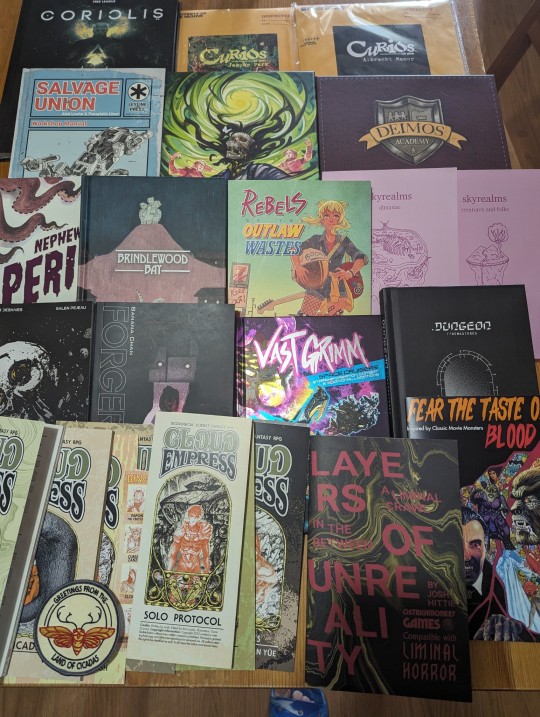
It's been a wild few months here at theInstaGrahame HQ, but what never fails to make me happy is the rad games I get from the mail. I'm getting over a cold, so I'mma work on this instead of anything productive I could be doing!
Here's my month of RPG mail calls, and why I'm hyped!
Coriolis: The Last Cyclade: I've been curious about Coriolis' Middle Eastern-themed sci-fi vibes for a while, so I put this on a Secret Santa wishlist; and this is what I got! Excited to dive in.
Curios: Albrecht Manor and Jasper Park: Good Luck Press is one of those game design teams I'll try anything from, and the pitch for this is really unique. It's not an RPG per se, as much as a collection of books, papers, maps, and other materials that point toward a mystery you get to figure out. Playing it is just... looking through stuff.
Salvage Union: I am a big fan of post-apocalyptic media, and a fan of the mecha genre. So, yeah, this was an easy sell. It's built on the Quest system, which I've been meaning to get more into anyway, and it looks like a mech repair manual!
The Zone (which I apparently thought people would just recognize): This game is available for free online, but the box set is gorgeous, and features some designers I love. Trying to set up an online session soon, but I do really want to play it in person.
Deimos Academy: Honestly, I picked it up because of the creative team, but also the pitch is great. I skipped my high school reunion, but if there was a chance to go back and face a monster? I might've thought about going.
Brindlewood Bay + Nephews in Peril: I was originally just going to get the super popular Elderly Detectives Solve Eldritch Crimes RPG, but the title of the expansion/mystery book was just too perfect.
Rebels f the Outlaw Wastes: I've already mentioned I like post-apocalyptica? Well, this took a neat approach to achievements/leveling that I was super intrigued by, and I just dig the fun vibe. The reason I like post-apocalyptic media is that it's hopeful, and this feels moreso than a lot of other stuff.
Skyrealms Almanac and Creatures and Folks: I've been into setting guides this past year. And like, this one is also a coloring book? Hell yeah.
Stoneburner: I've been following the creator on Twitter and elsewhere for a while, so I was curious about this title. But definitely sold when they talked about some of the inspiration being the original Starcraft games.
Forgery: Again, picked it up because I really like Banana Chan's work, but this is a paint-by-numbers solo RPG about forging a demonic painting. So like, yeah. That's rad.
Vast Grimm: Space Cruisers: Vast Grimm is Mork Borg in Space, but I'm also a big fan of ship catalogs, so I really wanted to check this one out.
.Dungeon: Everything Snow makes is beautiful, queer, and nostalgic, so when they mentioned a re-release of .Dungeon was coming, I really wanted to check it out. I have a lot of nostalgia for the
Cloud Empress (everything, including a patch!): I mean, you say Nausicaa and I'm listening. This has some roots in that world, but also does some really interesting things with the Mothership game engine. I'm especially intrigued by the notion of replacing racial traits with age traits, and having a series of pretty mundane jobs as the classes.
Layers of Unreality: The first of this month's Zine Club deliveries! I keep hearing about Liminal Horror, and this particular module I've heard nothing but incredible things about. So I'm really hyped to check out what happens in these backrooms.
Fear the Taste of Blood: My second Zine Club book this month! Kayla Dice is one of those really rad creators who I think deserves more attention than she gets, so I'm really hyped to dive into this take on classic movie monsters.

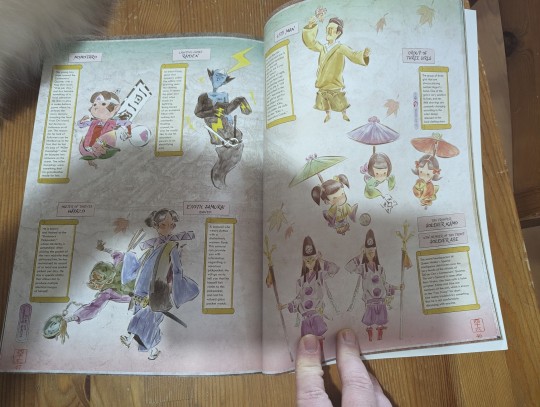
I also got this from my partner's family's Secret Santa.
Okami is one of those games that sticks with me, and has ever since I first saw images from it, and played it. It's a genuinely beautiful experience, and while it's maybe not a game everyone will like, it's one that I really enjoy, and the art is a big part of that.
It stands out as an example of what you can do with a video game that's nearly impossible with most other art forms, and also a reason that I don't think the Arms Race for More Photorealistic Graphics in video game consoles is worth the effort.
41 notes
·
View notes
Text

Endure the Dark is a grim dungeon crawl system-neutral series for any fantasy RPG. Detailed hand-drawn maps with random tables, to set your adventure, and explore these dungeon maps. Houses of Old is the third part of the series. A short selection of small dungeons that can be used for a one-shot D&D game, or for running a session on your ongoing campaign. Also a small guide on how to draw a dungeon map, with many blank pages to make your own maps.
48 notes
·
View notes
Note
this might be a big ask, but do you know of any fantasy adventure RPGs that does idk fantasy napolionics, not nesesarily actual napolionics with fantasy elements, but sorta 18th very early 19th century tech + magic and other fantasy stuff, pre/peri-industrial but only just, whfrpg leans (allover the place but) earlier, and a lot of other fantasy stuff with guns leans eather Piracy, or steapunk?
THEME: Fantasy Napoleonics.
Hello friend, there's a lot of different elements going on here, so I"m casting a pretty wide net to show you what's out there. I hope something in here strikes your fancy! I primarily looked for games that felt like they fell within the right time frame, but I also threw in some games that maybe fall just outside your parameters in the hopes they spark something for you.

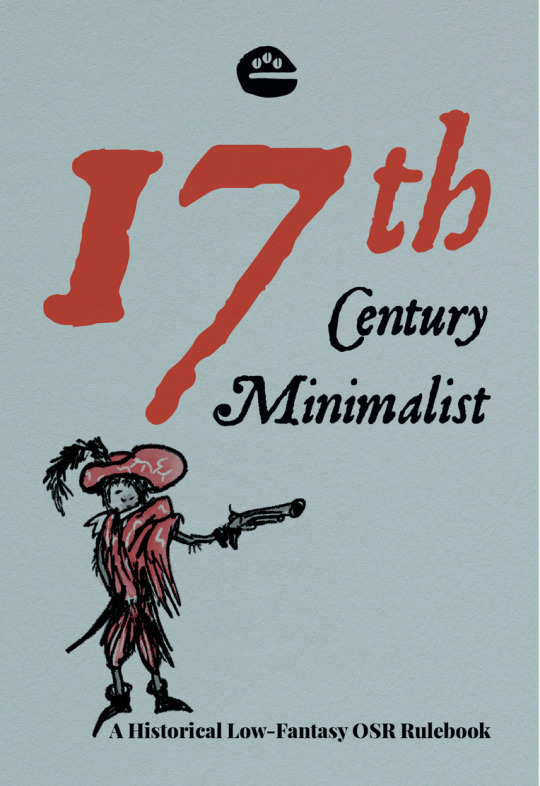



Castle Falkenstein, by R. Talsorian Games.
When computer game designer Tom Olam found himself sorcerously shanghaied by a rogue Wizard and a Faerie Lord, little did he suspect that he would soon become the pivotal force in the struggle to control an alternate Victorian Universe. But before the deadly game could end, he would first have to battle gigantic Landfortresses, outwit Dragons, romance a beautiful Adventuress, and defeat the Evil legions of a Dark Court determined to destroy him at all costs. Then maybe, just maybe, he could find a way home again …
Originally published in 1994, Castle Falkenstein is set in the Victorian era, but with a magical twist. This is a world of swashbuckling and adventure, complete with elves, dwarves and magic - but also submarines, Sherlock Holmes, and England’s courtly sensibilities.
There’s going to be many different kinds of roleplaying options in this kind of game, including combat, feats of derring-do, and diplomacy! The thing that possibly makes this game a bit far from what you’re looking for is the ruleset. Rather than using dice, this game uses a deck of cards, with different suits being suitable for different tasks, while card value determines skill or difficulty.
When it comes to setting, however, you’re going to have a lot of great things to look at. The supplements for this game include The Lost Notebooks of Leonardo da Vinci, Curious Creatures, Steam Age, and more!
17th Century Minimalist, by Games Omnivorous.
Welcome to the 17th century minimalist.
This is a fast-paced and highly-deadly game with a pinch of black humour that puts characters as wanderers in 17th century Europe. You will play as tricksters, thieves, former soldiers, bankrupt swashbucklers and petty physicians, roaming the Old Continent in search of coin and glory. The system is designed to allow fast character creation, compatibility with other games (mostly in the OSR community) and a reckless style of play.
The closest thing to magic in this game is an illusionist, but that doesn't stop this game from pushing your imagination. Games Omnivorous is pretty well-regarded in the OSR community. 17th Century Minimalist is meant to be simplified, fast-paced, and deadly, with technology like flintlock fire-arms, and goals like searching for treasure and glory. If you want to see a fuller review of this game, I’d recommend looking at Questing Beast’s video that covers the rules and the layout of the game.
A Guide to Casting Phantoms in the Revolution, by World Champ Games Co.
A Guide to Casting Phantoms in the Revolution is a single-session roleplaying game, in which players work together to summon specters to fight the aristocracy during the French Revolution. Featuring the pentacrawl system, Guide is different every time you play. Played on a story map in the shape of a pentagram, create a cast of characters, interpret symbols to create unique moments, and have the phantoms do you bidding—or you’ll do theirs!
This is a game with a number of physical, in-person components required to play. However, if you just have the pdf, the creator also directs you to online resources that you can print for the full experience. You are members of a secret cabal, casting phantoms to help you fight. This is a game that evokes the feeling of a ritual, and might feel magical or personal depending on how you play. It’s a strange mix of thematic storytelling and complex mechanics, so it might not be for everyone, but if you want to feel like a cult enacting revenge through eldritch rituals, I’d recommend checking this out!
Tales from the Aerosphere, by EfanGamez.
Tales from the Aerosphere is an original steampunk TTRPG that is powered by the Neon Nights system, a system that prioritizes seemingly limitless character creation freedom. From medics, to assassins, to mechanics, to a literal barbarian, there are THOUSANDS of character combinations you can play in Tales from the Aerosphere.
This game has its own setting, but all of the set pieces could be dropped, altered or changed if you like. The focus on this game is on character creation: the creator has outlined a number of discrete parts that you can use to not just put a unique character together, but tell you something about the world you’re in. If you’re a Spy, then there’s some kind of international conflict that hasn’t blown open into full-out war yet - perhaps there’s technology being developed that some nations don’t want others to learn about.
The game is extremely steampunk, with airships, CogWare that gives you exceptional abilities, and Tesla technology. It’s going to be on the more fantastical side of things, so if you really want to immerse yourself in another world, why not give it a go?
Shot & Splinters, by Tom Mecredy.
Shot & Splinters is a tabletop roleplaying game of naval adventure, inspired by Horatio Hornblower, Aubrey & Maturin, and Richard Sharpe. Drawing on history but not beholden to it, the game is set against the backdrop of the Napoleonic Wars, thrusting your characters into the heart of the conflict.
If you want seafaring and piracy, this is probably the game for you. It’s set in a napoleonic time frame, but it has strange creatures located upon uncharted waters. The mechanics are OSR, so expect simple stats, tables upon tables of gear, and a hex crawl map of the uncharted seas. If you want more adventure in this world, you can also check out Beneath the Battlements, a city crawl that brings your characters through a city under invasion. Honestly, I think this game might be the closest on the list of what you're looking for in terms of technology level, and possibly theme.
Games I’ve Recommended in the Past
Lady Blackbird, by John Harper.
#dnd#historical games#steampunk#game recommendations#indie ttrpgs#tabletop games#asks#there's a lot of wide-reaching stuff here
64 notes
·
View notes
Text
A Spoiler-Free Guide for Fire Emblem: Genealogy of the Holy War
With a short introduction, mechanics, and notable sticky situations.
(A PDF version of this guide is available upon request.)
Fire Emblem: Genealogy of the Holy War is a SRPG (Simulation RPG) for the Super Famicom, released in 1996. You have likely arrived at this guide either because someone has recommended it to you or because, far in the future after I have written this, a remake of it has released and you want to go back and play the original to see what has changed and what hasn't. Either way, you were likely inspired to play it from its strong story- rumored or experienced- and aren't too clear on what the mechanics of it are. Maybe you've played a number of Fire Emblem games, but are nervous about this one due to its reputation as an odd duck. Maybe you've never touched a SRPG before, and have a very excited Jugdral fan of a friend shepherding you into playing it. Either way, this guide is for you.
This guide will attempt to avoid spoiling any story events, but for those who mind gameplay spoilers, it is organized in ascending order of how obscure each gameplay feature is to stumble upon- the last two sections (Sticky Situations and Secret Events) in particular are not usually encountered by an unspoiled first-time player. Nevertheless, I highly recommend at least reading up to the fourth to last section, "Recruitments"; it contains no identifying character information besides time of encounter and class, and you will likely reach no end of frustration attempting some of them without foreknowledge (or some very good guesses). NOTE: List of Conversations (Section 8b) does contain spoilers for recruitable characters. Peruse that section with caution if you do read past the Recruitments section.
This guide is meant for use with the Project Naga patch, though some characters will be referred to by their more modern names; these will be indicated with a slash mark between the two. (E.g. Edain/Aideen.)
Table of Contents: Section 1. The Small Differences of Genealogy of the Holy War Section 2. Main Objectives Section 3. Finances and Resource Management Section 4. Skills Section 5. Side Objectives Section 6. Genealogy Section 7. Recruitments Section 8. Conversations Section 9. Sticky Situations Section 10. Secret Events
Section 1. The Small Differences of Genealogy of the Holy War
Genealogy of the Holy War is similar to most other Fire Emblem games in the broad strokes of its mechanics. It has general gameplay of fighting enemy units with your army on a grid-based map, chance-based unit growth, most of your usual classes and weapons, et cetera. However, it has a number of differences, large and small, with later (and earlier) Fire Emblem games, some of which may make gameplay more difficult if unknown. The small differences are catalogued here.
1a. Movement
There are two principal differences to movement in Genealogy compared to in other Fire Emblem games. Firstly, all mounted units may move with their remaining movement after performing any action except conversation or seizing of a castle. Secondly, though terrain in this game that decreases movement exists as usual, there is also some terrain that increases movement; when walking on roads, all units may move 1.4x as many spaces as usual, rounded down. So, for example, a paladin (9 mov) on roads may move 12.6 spaces, but this is rounded down to 12. As a trade-off for this, roads, like some rare terrain seen in other Fire Emblem games, lower the avoid of any unit standing on them by 10% (represented by the small shield icon in the terrain window):

1b. Follow-up Attacks
While units in most Fire Emblem games can attack an enemy unit twice if they are faster by a certain amount, units in Genealogy require a skill to do so. This skill is called Pursuit (or Follow-Up, depending on your translation.) There are ways to attack more than once without Pursuit, but they are either more rare or not guaranteed. Pursuit allows for a follow-up attack if a unit's attack speed is greater than that of their opponent by 1 or more points.
1c. Critical Hits and Effective Damage
Much like follow-up attacks, units in Genealogy cannot naturally perform critical hits. There are four ways to perform a critical hit on most enemies in Genealogy: Being next to an immediate family member or lover (flat 20% critical hit rate bonus to anyone, including those who cannot naturally crit); having the Critical skill (skill% chance); or using a weapon that has been used to kill at least 50 enemies (skill% chance, plus 1% for each enemy killed above 50, up to 50% bonus at 100 kills); or having the Wrath skill (guaranteed critical hit as long as you are at 50%+1 HP or lower).
Critical hits in Genealogy follow the damage formula of doubling a unit's attack power before subtracting enemy defensive stats, rather than the more common tripling of a unit's damage output after enemy defense is subtracted. They are generally much more useful in the hands of units with lower Attack than normal.
Effective damage in Genealogy (bows vs. fliers, etc.) is simply calculated as an automatic critical hit on the target unit (if the attacking unit hits, of course.)
There is no critical avoid (dodge) stat in Genealogy.
Also, the minimum damage for any attack which lands is 1.
1d. Weapon Weight
All weapons in Genealogy have a weight stat. This stat is subtracted from the attack speed of the unit wielding the weapon. There is no way to counteract this speed penalty, and attack speed may be decreased below zero when utilizing particularly heavy weapons. This can lead to a negative Avoid stat.
1e. Weapon Repair
Weapons in Genealogy are infinitely reparable at any castle on the map. The price of repair is equal to the weapon's price, divided by the number of uses the weapon has when new, times the number of uses to be repaired.
For example, repairing a 38 use Silver Sword to full durability costs 5000 (sale price) / 50 (maximum uses) * 12 (uses missing) = 1200 gold.
Each weapon in the game that the player can receive is unique.
1f. Weapon Triangle
The weapon triangle in Genealogy of the Holy War is generally similar to in other Fire Emblem games. However, it is notably stronger; units gain Hit/Avo ±20 for advantage/disadvantage. Additionally, there is a magic "triangle", which functions similarly.
The weapon triangle is Swords>Axes>Lances>Swords
The anima magic triangle is Fire>Wind>Thunder>Fire
The interaction of light and dark magic with other varieties is Light=Dark>Fire/Wind/Thunder
1g. Experience Gain and Class Change
Units gain experience based on their level in relation to the enemy's. The lower their level is in comparison to the enemy's, the greater their experience gain. Class changes don't affect level; you will gain equal experience as a level 1 Knight Lord and a level 1 Troubadour.
Class changes can be performed once a unit reaches level 20, if they are not already a promoted class. They can be performed using the Class Change option at one's home castle. There is no reason not to promote as soon as possible; all classes have a flat level cap of 30.
The stat caps for each class are each class' stat bases plus 15, excepting HP which caps at 80. There is data out there on the base stats; however, I won't go into it here.
1h. Weapon Level
If you've played Engage, you'll be familiar with this, but if not: weapon level is inherent to the class a unit occupies, and can only be changed by class change or personal modifiers (more on the latter in the Genealogy section.) So, if your paladin has B swords, he will never have A swords, even if other paladins you encounter might have the latter.
1j. Enemy Reinforcements
Reinforcements generally do not spawn on the map as in other Fire Emblem games; they will almost always appear from the mouth of a castle. If you defeat all of an enemy commander's allied units and said commander is capable of movement, they will return to the castle they came from, enter it, and 1-2 turns later exit it with a squad of new units statistically identical to their previous squad.
1k. Saving
At the start of each turn, before you have moved any units, you can save in the map menu (i.e. the menu that appears when you press A on the map.) It's highly recommended to keep at least two saves; one save every turn, and one save after you capture a new castle. You can set the game to save automatically each turn in the Options menu by scrolling down to Autosave and selecting a slot (1 to 4).
Section 2. Main Objectives
2a. Seizing Castles
Chapter progression is made by seizing enemy castles after defeating the boss standing on them. Theoretically, castles may be captured in any order that you like; in practice, in most cases the way ahead to the next castle will be blocked until you capture the previous castle.
When you seize a castle, a short cutscene will play and the enemy units whose allegiance lies with that castle will disappear (allegiance can be checked in the second page of the unit menu; this same page contains skills and weapon level). At the start of the next enemy phase, the "[Name] castle seized" map events will trigger; formerly neutral castles may turn red, enemy and ally units may spawn, and terrain may be changed (for example, a bridge may be lowered or raised, a path may appear through difficult terrain, a gate may be opened, etc.) Keep an eye on castles you have not yet seized due to this.
Allied (green) and neutral (yellow) castles cannot be seized, and may lack some amenities of allied castles upon entrance.
2b. Losing Castles
Any enemy unit who reaches the entrance of a castle (that is not their own) will capture it. Allied and neutral castles will become enemy castles when this happens, and can be recaptured by your own units; however, player castles will be pillaged and will no longer be able to be recaptured.
If the player's home castle (the castle where you start the chapter) is captured by the enemy, it's game over, and you'll have to restart from your last save.
Section 3. Finances and Resource Management
3a. Unit-Specific Gold Pools and Trading
Unlike in every other Fire Emblem game to date, units in Genealogy have their own specific gold pools. They cannot trade gold with other units, unless those units are their lovers; if so, they can use the Give Gold command to give their lover all of their money.
Units also cannot trade with each other. In order to exchange items, they will have to sell them off at the Pawn Shop in the castle menu, where another unit may rebuy them for twice the sale price. Therefore, it's best to think carefully about who should defeat enemy units when a droppable item is in play. The money cap in the wallet is 50,000 gold; if you're reaching that cap, consider spending it on something so you don't waste any new money you earn.
3b. Thieves
Thieves are an exception to the above gold rules. Though they still can't receive gold from just anyone, they can attack enemy units to steal all the gold in their wallet. Additionally, they can give gold to any unit in the army.
3d. The Arena
Each chapter, beginning with Chapter 1, has an arena. This arena consists of seven opponents per chapter whom, upon defeat, will give the unit who defeated them experience and 1000-4000 gold (beginning with the weakest and increasing by 500 until the strongest is reached.) All units can enter the arena as many times as they like until they've reaped all the rewards- each and every unit in your army may face and defeat the seven opponents, rather than just one. If your unit's HP hits zero in the arena, they won't die, but their HP will be reduced to 1. However, winning a match in the arena restores a unit to full HP.
It's recommended to challenge the arena each chapter with all the units you intend to use, but you don't have to in order to complete the game. So, if you start getting tired of it, you can skip it... but it might be best not to.
Section 4. Skills
4a. What are Skills?
Skills are abilities that a unit can activate- generally in-combat, though sometimes they have out-of-combat effects. Various skills have various chances of activation (some are guaranteed, some rely on specific stat thresholds), so be aware.
4b. Skill Types
There are two different skill types- "Class Skills", those granted based on a unit's class, and "Personal Skills", those a unit has innately. All skills can mechanically either be class or personal skills- though most skills are only personal. Class skills, however, apply to every unit that is a member of the class- including faceless enemies. So watch out, and check out the skills present on the unit menu to make sure you do not meet a dire error.
4c. Skill List
(Note: Attack Speed is here abbreviated as Aspd.)
Pursuit/Follow-Up: Allows a unit to strike again after an enemy counterattack (or twice in a row if the unit themselves is counterattacking). Trigger: Unit's Aspd > enemy unit Aspd.
Critical: Allows a unit to perform a critical hit in combat, doubling their attack before enemy defense. Trigger: Skl%.
Adept: Allows a unit to attack twice in a row. Trigger: (Aspd + 20)%.
Accost: Triggers another round of combat upon the completion of the prior round. Trigger: [Unit Aspd - enemy Aspd + (unit HP/2)]%.
Pavise: Negates all incoming damage for 1 hit. Trigger: (Unit Level)%.
Steal: Takes all of an enemy's gold upon hit and adds it to the unit's personal wallet. Always activates.
Vantage: Unit attacks first when enemy unit initiates combat (treats it as if unit initiates combat). Trigger: Unit HP ≤ (50% of unit's Max HP + 1). When conditions are met, always activates.
Wrath: Unit always performs a critical hit (if unit hits). Trigger: Unit HP ≤ (50% of unit's Max HP + 1). When conditions are met, always activates.
Astra: Unit performs 5 attacks in a row. Trigger: Skl%.
Luna: Unit negates enemy defense for 1 strike. Trigger: Skl%.
Sol: Unit recovers HP equal to damage dealt. Trigger: Skl%.
(Note: Only one of Astra/Luna/Sol may activate at once. Additionally, they are only usable by infantry sword units.)
Nihil: Prevents the activation of Astra, Luna, Sol and critical hits against this unit. Always activates.
Bargain: Shop prices for this unit are reduced by 50%.
Charm: Hit and Avoid +10 to allied units within 3 spaces.
Dance: Grants another action to all adjacent allies.
Miracle: When unit HP is ≤10, increases unit's Avo by [(11- Unit HP)*10] points.
Paragon: Double's unit's gained experience.
Renewal: At start of turn, unit recovers 5-10 HP (random).
Section 5. Side Objectives
5a. Villages
Visiting a village gives a unit 5000 Gold and may also grant an item. Bandits will attack villages; a village will be destroyed when a bandit attacks it for 10 turns, and every turn that a bandit attacks it will subtract 500 Gold from the total that a unit will gain from visiting it.
5b. Combatant NPCs
NPCs ("green units") that have normal classes will grant items when spoken to by certain units of yours. Their status screen will tell you who they should talk to.
5c. Civilian Rescue
NPCs who do not have normal classes (i.e. their class is Civilian) will grant 100 EXP when interacted with.
Section 6. Genealogy
6a. What's All This About Children?
Like Gaul, Genealogy of the Holy War is divided into two parts... Er, it seems I've misread my notes. Gaul is divided into three. Nevertheless, Genealogy takes place over a long period of time- 24 years, in fact. As the characters you recruit at the beginning of the game are in the prime of their lives, it's only natural that, over such a long period, some of them will marry and have children. However, the latter half of the game takes place over two decades later than the beginning- the characters that you've recruited back then, such as Edain, may be in their forties by that point. By no means can characters in their early middle ages not fight in the early middle ages, but this IS an anime- the timeskip calls for a new cast of teenagers, the children of your early units all grown up.
6b. Can Love Bloom on the Battlefield?
Units can only have children if they become lovers. Some units will be- or become- lovers automatically, such as Quan and Ethlyn. In this case, their children will always be theirs. Some units do not- take, for example, Edain. She will not automatically take a lover, and you'll have to get her to fall in love with another (male) unit in order to have children. (Evidently, Jugdral has not yet invented magic that allows for cloning or IVF. Sad.) Even if she doesn't fall in love, however, you'll still have the same number of teenagers fighting for you later in the game- two of them will simply not be the child of any of your own units, and will be "substitute" characters with their own backstories. However, the children of early-game units will have some gameplay advantages, which I'll explain in a bit. Either way, each potential mother has two associated children, one of which will take after her to a greater extent and the other of which will take after her lover to a greater extent. No male unit has any associated children without falling in love.
As for how units fall in love, it's quite simple. Units have a certain number of "love points" with each other- all of them start with a certain number of points shared with each other unit. Once a unit reaches 500 love points with another unit, they become lovers, and can have conversations, gameplay interactions, and children. Units gain +5 love points per turn from standing next to each other, as long as they are the only two units standing next to each other; there is a bug that can cause units to gain love points meant for other units if they stand next to another unit who is standing next to that unit's prospective lover. There is a more detailed explanation, but it would involve some spoilers, so I'll leave it at that for now. Units also gain a certain number of love points by being on the same map together; this can be as low as 1 and as high as 10 per turn for a given pair. Finally, units gain love points by having conversations with each other- conversations between unrelated men and women often come with love points attached.
Perhaps this explanation has been tiresome, and I haven't convinced you you shouldn't just toss up your hands and go for the substitutes. Well, there are many gameplay benefits to kids, starting with the following...
6c. Holy Blood
It's hard to miss, considering how constantly it's talked about. Some of your units are descendants of the Twelve Crusaders, who destroyed the darkness about a hundred and twenty years ago. This has numerous story implications. However, it also has gameplay ones!
If you open up a unit's Holy Blood menu (press A on the unit menu) you'll see a circle showing all twelve of the Crusaders' weapons and their names. Some of these will have green dots next to them; when a green dot is next to a Crusader's weapon, that means that the unit has Minor holy blood of that crusader; when the green dot is glowing (there's a yellow light surrounding it) that means that the unit has Major holy blood of that crusader.
Minor holy blood boosts a unit's rank in the associated weapon by 1 letter grade. For example, Troubadours naturally have a B rank in swords, but because Ethlyn has minor Baldr blood, she starts with an A rank. Meanwhile, Major holy blood boosts a unit's rank in the associated weapon to the maximum, and allows them to use the associated holy weapon if they can get their hands on it. For example, because Sigurd has major Baldr blood, he can use any sword in the game (excepting other holy weapons), including Tyrfing. This isn't just a nice bonus- most holy weapons give a total of +30 to a character's stats, spread out across a varying number. Some give more or less, or have other special effects (for example, Mystletainn grants the Critical skill), but they are universally extraordinarily powerful. A unit with holy blood can turn the tide of battle on their own, in both gameplay and story.
Holy blood also increases a unit's growths. Depending on which holy blood they bear, various stat growths are boosted; a list is shown below. Note that minor blood cuts these boosts in half.
Baldr: Associated with swords. HP+20%, Str+10%, Skl+10%, Lck+10%. Od: Associated with swords. HP+20%, Skl+30%.
Dáinn: Associated with lances. HP+20%, Spd+30%.
Ullr: Associated with bows. HP+20%, Lck+30%.
Bragi: Associated with staves. HP+10%, Mag+10%, Lck+10%, Res+20%.
Thrud: Associated with thunder magic. HP+20%, Skl+30%.
Fjalar: Associated with fire magic. HP+20%, Mag+30%.
Hoðr: Associated with swords. HP+20%, Str+30%.
Njörun: Associated with lances. HP+20%, Str+10%, Spd+10%, Def+10%.
Nál: Associated with axes. HP+20%, Def+30%.
Naga: Associated with light magic. HP+10%, Mag+20%, Res+20%.
Forseti: Associated with wind magic. HP+20%, Spd+30%.
Children will inherit their parents' holy blood, but only partially; both children will inherit minor holy blood, if it is held, but only the child which most resembles the parent will inherit major holy blood. The other child will again receive minor holy blood, unless both parents share a holy blood type, in which case they will both bear major holy blood. This is the case even if both parents' holy blood is minor.
6d. Weapon and Skill Inheritance
Units will inherit the weapons and items of the parent they most resemble, but only if they can use them in their base class. The exception to this is Holy Weapons, which will be inherited even if the child unit can never use them.
Both parents' personal skills pass on to both of their children. However, their class skills do not. Check carefully to see that the skills you want to pass on actually belong to the unit innately!
6e. Growth Rate Inheritance
Child units' growth rates are equal to 100% of those of the parent they resemble most + 50% of those of the parent they resemble less. Therefore, all child units will be equally or more competent in battle than their resembling parent.
Section 7. Recruitments
7a. From Enemy to Friend
Units in Genealogy of the Holy War won't always be on your side from the start. Oftentimes, they'll start out as green allied units, or even enemy units. While talking to enemies to recruit them is common in Fire Emblem games, Genealogy has some more esoteric methods on its hands. Therefore, a list of (non-automatic) recruitment methods and chapters (without mentioning unit names) is below.
7b. Spoiler-Free Recruitment List
Chapter 1.
-Speak to the swordfighter with your lord after seizing Genoa.
Chapter 2.
-Complete all seven Arena matches with any unit.
-Speak to the princess with your lord.
-Speak to the free knight with anyone holding more than 10,000 Gold.
-Speak to the pegasus with the bard.
Chapter 6.
-Speak to either the axe fighter or the axe knight with the lady swordfighter.
Chapter 7.
-Enter Dahna castle with the cavalier who worries for it.
-Speak to the mage girl with the other mage.
Chapter 8.
-Speak to the archer with the thief.
-Speak to the sage with your lord.
Chapter 9.
-Seize Luthecia while the general still lives.
-Talk to the general with the cleric from Luthecia.
-Talk to the wyvern knight with the prince.
-Talk to the wyvern knight with your lord.
Epilogue.
-Speak to them with your lord after seizing Velthomer.
Section 8. Conversations
8a. Communication is Key
Though supports weren't introduced into the Fire Emblem series until Binding Blade, that by no means that units did not talk about their past and present with each other prior to it. Units in Genealogy of the Holy War can talk to each other on the map for lore, love, stats, and items. The "Unit" section of the map menu contains a list of all units who can speak to each other on page 4 ("Personal Data"). It's highly recommended that you utilize this; though all units will have who they can talk to listed on the second page of their unit screen, it's easy to miss conversations without this.
Conversations have several triggers, but the most common one is the seizure of a castle. A list of all conversations between allied units, triggers, and results (things obtained from said conversation) is below. Initiator of the conversation is listed first, who they speak to is listed afterwards, trigger conditions third, and rewards fourth.
8b. List of Conversations, Conditions, and Results
Note that all events that can cause love point gain will not occur if either participant in the conversation already has a lover.
Prologue:
Azelle->Sigurd, Azelle recruited Lex->Sigurd, Lex recruited Ethlyn->Sigurd, Ethlyn recruited Quan->Sigurd, Quan recruited
Chapter 1:
Quan->Finn, from start of chapter, Finn gains +1 Str/Skl/Def Sigurd->Edain/Aideen, Edain recruited Midir->Edain, Edain recruited and Azelle has not spoken to her, +100 love points Azelle->Edain, Edain recruited and Midir has not spoken to her, +100 love points Edain->Ethlyn, Edain recruited, Ethlyn gains Return staff Quan->Ayra, Ayra recruited Dew->Edain, Genoa seized, 50 love points + Edain gains Warp staff
Chapter 2:
Deirdre->Ethlyn, from start of chapter, Ethlyn gains Light Brand Dew->Raquesis/Lachesis, Lachesis recruited, +50 love points and Lachesis gains Thief Sword Quan->Finn, Heirhein seized, Finn gains Brave Lance Sigurd->Lewyn, Lewyn recruited Beowulf->Lachesis, Anphony/Infini seized, +100 love points and Lachesis gains Str+2, Skl+2, Def+1 Alec->Sylvia/Silvia, Infini seized, +100 love points Silvia->Sigurd, Silvia recruited Fury/Erin/Erinys->Sigurd, Erinys recruited
Chapter 3:
Lex->Ayra, from start of chapter and Chulainn has not spoken to Ayra, +100 love points and Ayra gains Brave Sword Holyn/Chulainn->Ayra, from start of chapter and Lex has not spoken to Ayra, +100 love points and Ayra gains Brave Sword Ethlyn→Quan, Sylvale seized, Quan gains Gae Bolg Sigurd -> Brigid, Brigid recruited Edain→Brigid, Brigid recruited, Brigid gains Yewfelle Midir-> Brigid, Brigid recruited, +100 love points Claud->Sigurd, Claud recruited
Chapter 4:
Taillte/Tailtiu->Azelle, if the two are not lovers, +100 love points and Azelle gains HP+5 Sigurd->Claud, from start of chapter Edain->Midir, if the two are lovers, Midir gains Brave Bow Edain->Jamke, if the two are lovers, Jamke gains Brave Bow Edain->Azelle, if the two are lovers, Edain gains Rescue staff Silvia->Claud, Thove/Tófa seized, +100 love points Lewyn->Sigurd, Silesse seized Erinys->Lewyn, Silesse seized, +290 love points
Chapter 5:
Edain->Brigid, from start of chapter Claud->Edain, if the two are lovers, Edain gains Rescue staff Sigurd->Ayra, Lubeck seized Lex->Azelle, Lubeck seized Dew->Jamke, Lubeck seized Tailtiu->Azelle/Claud/Lex, if the two are lovers and Phinora seized Erinys->Lewyn/Arden/(Noish/Naoise), if the two are lovers and Phinora seized Silvia->Claud/Lewyn/Alec, if the two are lovers and Phinora seized Lachesis->Beowolf/Naoise/Dew, if the two are lovers and Phinora seized Ayra->Lex/Chulainn/Arden, if the two are lovers and Phinora seized Brigid->Alec/Jamke/Midir, if the two are lovers and Phinora seized
Chapter 6:
(Scathach/Ulster)/(Roddlevan/Dalvin)->Larcei/(Radney/Creidne), from start of chapter, Larcei/Creidne gains Lck+1 Lester/(Dimna/Deimne)->Lana/(Mana/Muirne), Lester/Deimne recruited, Lana/Muirne gains Lck+1 Oifey->Seliph, Oifey recruited Lana/Muirne->Julia, Julia recruited, Julia gains Mend staff Fee/(Femina/Hermina)->Seliph, Fee/Hermina recruited Arthur/Amid->Seliph, Arthur/Amid recruited Julia->Seliph, Isaach conquered, Julia gains Nosferatu tome (recommended) Julia->Seliph, Sophara conquered, Julia gains Aura tome Seliph->Lana/Muirne, Sophara conquered, +100 love points
Chapter 7:
Shannan->Patty/Daisy, from start of chapter, +100 love points and Shannan gains Balmung Oifey->(Dermott/Diarmuid)/Tristan, from start of chapter, Diarmuid/Tristan gains +1 Str/Skl/Def Seliph->Shannan, from start of chapter, Seliph gains +1 Skl Larcei/Creidne->Shannan, from start of chapter, +100 love points and Larcei/Creidne gains +2 Skl Patty/Daisy->Seliph, Yied/Aed is seized, +100 love points and Seliph gains Brave Sword Leif->Seliph, from start of chapter Diarmuid/Tristan->Nanna/Jeanne, from start of chapter, Nanna/Jeanne gains +1 Lck Ares->Seliph, Ares recruited Lene/Laylea->Seliph, Lene/Laylea recruited (Tine/Tinni)/Linda→Seliph, Tine/Linda recruited Finn→Nanna, if he is her father, Nanna gains +5 Spd Finn-> Lana, if he is her father, Lana gains +5 Mag Finn-> Larcei, if he is her father, Larcei gains +5 Skl
Chapter 8:
Julia->Seliph, at start of map, Seliph gains Lck+1 Arthur/Amid->Fee/Hermina, from start of map, +100 love points and Fee/Hermina gains +3 HP Finn->Leif, from start of map, Leif gains Str +3 Faval/Febail->Seliph, Febail recruited Seliph->Tine/Linda, Connacht seized, +100 love points and Tine/Linda gains +3 HP Nanna->Ares, Connacht seized, Nanna gains +2 Str/Def Ced->Seliph, Ced recruited with Lewyn as his father, Ced gains +3 Lck Fee/Hermina->Ced/Hawk, Ced/Hawk recruited, Fee/Hermina gains +1 Lck
Chapter 9:
Febail/Asaello->Patty/Daisy, from start of map, Patty/Daisy gains +1 Lck Patty/Daisy->(Coirpre/Cairpre)/(Sharlow/Charlot), Coirpre/Charlot recruited, +100 love points and Coirpre/Charlot gains +3 HP Seliph->Hannibal, Hannibal recruited Lene/Laylea->Coirpre/Charlot, Hannibal recruited, Coirpre/Charlot gains +1 Lck Julia->Seliph, Grutia seized, Seliph gains +3 Res Finn/Hannibal->Altena, Grutia seized, Altena gains +3 HP
Chapter 10:
Lester/Deimne->Patty/Daisy, from start of map, +100 love points and Patty/Daisy gains +3 HP Nanna/Jeanne->Leif, from start of map, +100 love points and Nanna/Jeanne gains +3 HP Shannan->Seliph, from start of map, Shannan gains +3 HP Febail/Asaello->Lana/Muirne, from start of map, +100 love points and Lana/Muirne gains +3 HP Oifey->Seliph, Chronos seized, Oifey gains +3 HP Leif->Altena, from start of map, Altena gains +1 Lck Seliph->Fee, Rados seized and Lewyn is her father, Fee gains Str +5 Seliph->Lene, Rados seized and Lewyn is her father, Lene gains Def +5 Seliph->Tine, Rados seized and Lewyn is her father, Tine gains Mag +5 Coirpre/Charlot->Altena, Miletos seized, Altena gains +5 Res
Epilogue:
Arthur/Amid->Tine/Linda, from start of map if neither has a lover, Tine/Linda gains Lck+1 Tine/Linda->Seliph/Ced/Hawk/Leif, if the two are lovers, Seliph/Ced/Hawk/Leif gains Mag+3 Patty/Daisy->Seliph/Shannan/Lester, if the two are lovers, Seliph/Shannan/Lester gains +3 HP/Spd Daisy->Deimne, if the two are lovers, Deimne gains +5 HP Jeanne->Leif, if Edda is seized and the two are lovers, Leif gains +5 HP Muirne->Asaello, if Edda is seized and the two are lovers, Asaello gains +5 HP Nanna/Jeanne->Seliph, if Edda is seized and the two are lovers, Seliph gains +3 HP Nanna->Ares/Leif, if Edda is seized and the two are lovers, Ares/Leif gains +3 Def Lana/Muirne->Seliph/Scathach/Dalvin, if Dozel is seized and the two are lovers, Seliph/Scathach/Dalvin gains +3 Res Lana->Febail, if Dozel is seized and the two are lovers, Febail gains +3 Res Larcei/Creidne->Seliph/Iuchar/Iucharba/Shannan, if Dozel is seized and the two are lovers, Seliph/Iuchar/Iucharba/Shannan gains +3 Str Fee->Oifey, if Friege is seized and the two are lovers, Oifey gains +3 Skl Fee/Hermina->Seliph/Arthur/Amid, if Friege is seized and the two are lovers, Seliph/Arthur/Amid gains +3 Skl
Section 9. Sticky Situations
9a. Large, Progressive Maps
Portions of the maps in Genealogy open up as you progress through them and seize castles. While this does lead to some impressive storytelling, it can also lead to you being caught in an unfortunate situation because you're halfway across the map for where some new event is happening. I call this a "sticky situation", and have provided hints for dealing with them below.
9b. Hints for Sticky Situations
Chapter 1. Leave a unit to guard your home castle. The young man won't attack the woman he saved, but his fellows will.
Chapter 2. The northeast passage will open when your lord is in the least convenient location for it. Consider preparing for the worst beforehand, and sending a particularly moralizing young artist home ahead of time.
Chapter 3. Be prepared for sneak attacks from the west and the north, again when you're in the most inconvenient location for them. Think of the feelings of your recently-recruited units about the ones closest to them- maybe communication is the answer.
Chapter 4. If you like money, don't abandon the northeast entirely when duty calls elsewhere. Just don't leave your best units there. It's only provincial. Thieves can pick any lock, even when it's that of a drawbridge. If one were to be raised, they could lower it in no time.
Chapter 5. Units will automatically equip plot-relevant weapons. Even if they're broken.
Chapter 6. Better movement options don't necessarily result in a better outcome. Weigh all the pros and cons first.
Chapter 7. Your unlucky number is one greater than the number of Crusaders. Get a move on! Pegasi are broadly applicable to understaffing situations.
Chapter 8. Just because someone doesn't have Pursuit doesn't mean they won't attack you twice. Use more reliable methods. Thieves work in exactly the same way when they're your enemies.
Chapter 9. Never trust convenient roads that you didn't ride in on. Keep your guard up at home.
Chapter 10. If you're not willing to abuse critical hits and avoid stacking in the face of insurmountable odds, you'll have to either make sacrifices or count tiles very precisely. Consider sending winged beasts as close as you can to the cliffs east of your homeland before arriving there yourself.
Epilogue. Keep the one who inherited a blessing they knew not of until recently close to home. If you give a sage a magic ring and the right tools to use it wisely, you might be able to minimize your distress from enemies who mirror their abilities in the final stages of the war. Beware movement ranges.
Section 10. Secret Events
10a. What Is A Secret Event?
Secret events are events that the game does not outright inform you will occur if you perform certain actions. Some of these events are meant to be easy to infer (the Not-So-Secret-Events) and some a player would only figure out by looking them up in the manual (the Truly Secret Events). The Not-So-Secret Events are highly recommended for all players to prioritize due to their notable gameplay impact, and are difficult to miss if you read every conversation. The Truly Secret Events are fun, but if you wish to stay as unspoiled as possible, consider skipping them.
10b. Not-So-Secret Events
Chapter 4: After seizing Silesse, have its heir enter it. They will receive an important item.
Epilogue: After seizing Velthomer, have the most recently recruited character enter it. They will receive an important item.
10c. Truly Secret Events
Chapter 1:
A. Have Lex wait on the marked spot with an Iron Axe equipped. A conversation will occur, and he will receive a Brave Axe.
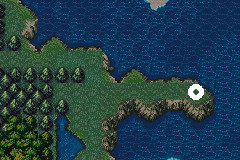
Chapter 2:
A. Have Arden wait on the marked spot. If he does not have a lover, a conversation will occur, and he will receive the Pursuit Ring.

B. After capturing Heirhein, have a male character wait next to the neutral soldier just north of Evans castle for a conversation to occur.
Chapter 3:
A. Have Dew wait directly in front of Bragi Tower and he will receive the Wind Sword.
Chapter 4:
A. Prior to seizing Tófa/Thove, if neither Silvia, Lewyn, or Erinys have a lover, a conversation will occur if Silvia waits next to Erinys. Silvia will gain a large number of love points with Lewyn, while Erinys will gain a smaller number.
B. Have Silvia visit the second-most right-hand village on the map. An event will occur, and Silvia will receive the Safeguard/Defense Sword.
Chapter 5:
A. Have Arden wait on the marked spot. If he has a lover, he will gain 5 points of Skill.

Chapter 6:
A. Have Seliph visit the village directly northwest of Isaach castle, and a different conversation will occur than usual.
B. Before conquering Ganeishire, Lester, Deimne/Dimna, Diarmuid/Dermott/Delmud, or Tristan can speak to the neutral soldiers of Sophara or Isaach castle.
C. If Deimne enters Isaach castle, a conversation will occur, and his Strength will increase by 5 points.
D. If Johan/Iuchar or Johalva/Iucharba waits next to Radney/Creidne for 10 turns, a conversation will occur, and Creidne's Strength and Luck will increase by 2 and 3 points, respectively.
Chapter 7:
A. If Laylea visits one of the villages south of Leonster, a conversation will occur, and she will receive the Barrier Blade.
B. After the boss of Ulster castle has been defeated, if Daisy waits next to Shanan, a conversation will occur, and Daisy's Skill and Speed will increase by 3 points.
C. After Melgen has been seized, if Tristan and Roddlevan/Dalvin are both below level 10, having them wait next to each other will cause a conversation to occur and both of them to gain Strength +2 and Def +1; Tristan will gain Speed +1, while Dalvin will gain Defense +1.
Chapter 8:
A. If Fee waits on the marked location before the character guarding Munster castle is recruited, a conversation will occur.
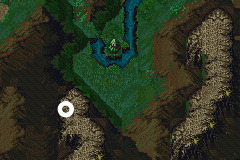
B. If Linda waits on the left-hand marked spot, a conversation will occur, and she will gain Resistance +3. If Amid waits on the right-hand marked spot, a conversation will occur, and he will gain Resistance +3.

C. If Asaello visits the village northwest of Connacht, a conversation will occur and his Strength will increase by 3.
D. After Connacht has been seized, if neither Seliph nor Muirne/Mana have a lover, and if all characters recruited from chapter 6 onwards have survived so far, have Seliph wait next to Muirne. A conversation will occur, and Muirne will gain Luck +5.
Chapter 9:
A. If Hawk enters Luthecia, a conversation will occur, and he will gain +3 Magic and Resistance.
B. After Grutia is conquered, have Charlot/Sharlow wait next to Hannibal. A conversation will occur, and he will receive the Berserk staff.
C. If Femina/Hermina or Janne/Jeanne visits one of the northwest villages, a conversation will occur and she will gain +3 Defense.
Chapter 10:
A. If Seliph defeats the boss of the final castle and before seizing it waits next to the water on the beach below, something will happen.
59 notes
·
View notes